When The Mermaids Cry: The Great Plastic Tide
Posted in Coastal Care.org by Claire Le Guern Lytle
Introduction
The world population is living, working, vacationing, increasingly
conglomerating along the coasts, and standing on the front row of the
greatest, most unprecedented, plastic waste tide ever faced.
Washed out on our coasts in obvious and clearly visible form, the
plastic pollution spectacle blatantly unveiling on our beaches is only
the prelude of the greater story that unfolded further away in the
world’s oceans, yet mostly originating from where we stand: the land.
In 2008, our global plastic consumption worldwide has been estimated
at 260 million tons. Plastic is versatile, lightweight, flexible,
moisture resistant, strong, and relatively inexpensive. Those are the
attractive qualities that lead us, around the world, to such a voracious
appetite and over-consumption of plastic goods. However, durable and
very slow to degrade, plastic materials that are used in the production
of so many products all, ultimately, become waste with staying power.
Our tremendous attraction to plastic, coupled with an undeniable
behavioral propensity of increasingly over-consuming, discarding,
littering and thus polluting, has become a combination of lethal nature.

African coast marine debris. Photo: Candace Feit
A simple walk on any beach, anywhere, and the plastic waste spectacle
is present. All over the world the statistics are ever growing,
staggeringly. Tons and tons of plastic debris (which by definition are
waste that can vary in size from large containers, fishing nets to
microscopic plastic pellets or even particles) is discarded every year,
everywhere, polluting lands, rivers, coasts, beaches, and oceans. Last
year, an estimated 150,000 tons of marine plastic debris ended up on the
shores of Japan and 300 tons a day on India’s coasts.>
Lying halfway between Asia and North America, north of the Hawaiian
archipelago, and surrounded by water for thousands of miles on all
sides, the Midway Atoll is about as remote as a place can get. However,
Midways’ isolation has not spared it from the great plastic tide either,
receiving massive quantities of plastic debris, shot out from the North
Pacific circular motion of currents (gyre). Midways’ beaches, covered
with large debris and millions of plastic particles in place of the
sand, are suffocating, envenomed by the slow plastic poison continuously
washing ashore.
Then, on shore, the spectacle becomes even more poignant, as
thousands of bird corpses rest on these beaches, piles of colorful
plastic remaining where there stomachs had been. In some cases, the
skeleton had entirely biodegraded; yet the stomach-size plastic piles
are still present, intact.
Witnesses have watched in horror seabirds
choosing plastic pieces, red, pink, brown and blue, because of their
similarity to their own food. It is estimated that of the 1.5 million
Laysan Albatrosses which inhabit Midway, all of them have plastic in
their digestive system; for one third of the chicks, the plastic
blockage is deadly, coining Midway Atoll as “albatross graveyards” by
five media artists, led by photographer Chris Jordan, who recently
filmed and photographed the catastrophic effects of the plastic
pollution there.
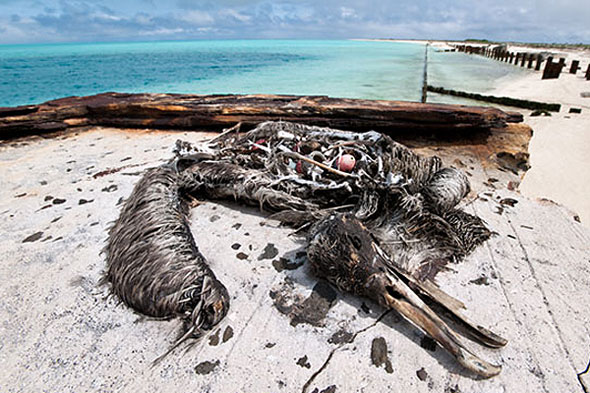
Albatross, victim of plastic ingestion. Photo: Unknown.
From the whale, sea lions, and birds to the microscopic organisms
called zooplankton, plastic has been, and is, greatly affecting marine
life on shore and off shore. In a 2006 report,
Plastic Debris in the World’s Oceans,
Greenpeace stated that at least 267 different animal species are known
to have suffered from entanglement and ingestion of plastic debris.
According to the National Oceanographic and Atmospheric Administration,
plastic debris kills an estimated 100,000 marine mammals annually, as
well as millions of birds and fishes.
The United Nations Joint Group of Experts on the Scientific Aspects
of Marine Pollution (GESAMP), estimated that land-based sources account
for up to 80 percent of the world’s marine pollution, 60 to 95 percent
of the waste being plastics debris.
However, most of the littered plastic waste worldwide ultimately ends
up at sea. Swirled by currents, plastic litter accumulates over time at
the center of major ocean vortices forming “garbage patches”, i.e.
larges masses of ever-accumulating floating debris fields across the
seas. The most well known of these “garbage patches” is the Great North
Pacific Garbage Patch, discovered and brought to media and public
attention in 1997 by Captain Charles Moore. Yet some others large
garbage patches are highly expected to be discovered elsewhere, as we’ll
see further.
The plastic waste tide we are faced with is not only obvious for us
to clearly see washed up on shore or bobbing at sea. Most
disconcertingly, the overwhelming amount and mass of marine plastic
debris is beyond visual, made of microscopic range fragmented plastic
debris that cannot be just scooped out of the ocean.
Slow, silent, omnipresent, ever increasing, more toxic than
previously thought, the plastic pollution’s reality bears sobering
consequences, as recently unveiled by the report of Japanese chemist
Katsuhiko Saido at the 238th National Meeting of the American Chemical
Society (ACS) in August 2009 and the findings from the Project Kaisei
and Scripps (Seaplex) scientific cruise-expeditions collecting seawater
samples from the Great Garbage Patch. Both, the reports and expeditions
uncovered new evidence of how vast and “surprisingly” (as it was termed
at the ACS meeting) toxic the plastic presence in the marine environment
is.

Photo: Kuta Beach, Bali by Claude Graves
Environmentalists have long denounced plastic as a long-lasting
pollutant that does not fully break down, in other terms, not
biodegradable. In 2004, a study lead by Dr Richard Thompson at the
University of Plymouth, UK, reported finding great amount of plastic
particles on beaches and waters in Europe, the Americas, Australia,
Africa and Antarctica.
They reported that small plastic pellets called
“mermaids tears”, which are the result of industry and domestic plastic
waste, have indeed spread across the world’s seas. Some plastic pellets
had fragmented to particles thinner than the diameter of a human hair.
But while some cannot be seen, those pieces are still there and are
still plastic. They are not absorbed into the natural system, they just
float around within it, and ultimately are ingested by marine animals
and zooplankton (Plankton that consists of tiny animals, such as
rotifers, copepods, and krill, larger animals eggs and larvae’s and of
microorganisms once classified as animals, such as dinoflagellates and
other protozoans.).
This plastic micro-pollution, with its inherent
toxicity and consequences on the food chain, had yet to be studied…
Dr Saido’s study was the first one to look at what actually happens
over the years to these tons of plastic waste floating in the world’s
oceans. The study presents an alarming fact: these tons of plastic waste
reputed to be virtually indestructible, do decompose with surprising
speed, at much lower temperature than previously thought possible, and
release toxic substances into the seawater, namely bisphenol A (BPA) and
PS oligomer. These chemicals are considered toxic and can be
metabolized subsequent to ingestion, leading Dr Saido to state
“…plastics in the ocean will certainly give rise to new sources of
global contaminations that will persist long into the future”.
This past August a different study, from a group of oceanography
students from Scripps Institution of Oceanography (SIO), UCSD,
accompanied by the international organization Project Kaisei’s team,
embarked on two vessels,
New Horizon and
Kaisei,
through the North Pacific Ocean to sample plastic debris and garbage.
SIO director Tony Haymet described the trip as “ …a forage into the
great plastic garbage patch in the north.” To summarize the scientific
data collected on the ship, Miriam Goldstein, chief scientist on
New Horizon,
stated: “We did find debris… coming up in our nets in over 100
consecutive net tows over a distance of 1,700 miles… It is pretty
shocking.”
She said, “[There is] not a big island, not a garbage dump
[that we] can really see easily.” She described it more as a place where
large debris floats by a ship only occasionally, but a lot of tiny
pieces of plastic exist below the surface of the water. “Ocean pretty
much looks like ocean,” she said. “The plastic fragments are mostly less
than a quarter inch long and are below the surface. It took at first a
magnifying-glass to see the true extent of plastic damage in the North
Pacific.”
The overwhelmingly largest unquantifiable plastic mass is just made of confetti-like fragmented pieces of plastic.
In a press conference in September 2009, the director of the
California Department of Toxic Substances Control (DTSC), Maziar
Movassaghi, referring to Project Kaisei’s findings, held a small glass
bottle filled with seawater sampled at the Great North Garbage Patch.
Inside was murky seawater with hundreds of fragmented plastics pieces:
“That is what we have to stop”.
All sea creatures, from the largest to the microscopic organisms,
are, at one point or another, swallowing the seawater soup instilled
with toxic chemicals from plastic decomposition. The world population “…
(is) eating fish that have eaten other fish, which have eaten
toxin-saturated plastics. In essence, humans are eating their own
waste.” (Dixit Renee Brown, WiredPress).
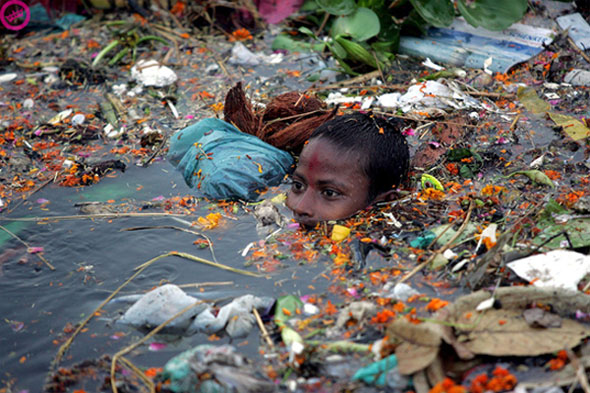
Photo: Manan Vastsyayana
The scientists from Project Kaisei and Scripps hope their data gives
clues as to the density and extent of these debris, especially since the
Great Pacific Garbage Patch might have company in the Southern
Hemisphere, where scientists say the gyre is four times bigger.” We’re
afraid at what we’re going to find in the South Gyre, but we’ve got to
go there,” said Tony Haymet.
The “Silent World” is shedding mermaid tears. A plastic-poison has
undeniably been instilled by us, prompting an unwilling and illegitimate
confrontation of two titans: one synthetic (plastic), the other
oceanic. The crisis is of massive proportion. An unprecedented plastic
tide has occurred, pervasively affecting the world’s oceans, beaches,
coasts, seafloor, animals and ultimately, us.
I: The Great Plastic Tide: Magnitude, Scope, Extent
A full understanding of the magnitude and scope of this plastic
pollution starts with clear definitions as to what and why it is
happening. Thus, we will define the notions of marine debris, gyres, and
oceanic garbage patches, or giant floating marine debris field, as
first discovered in the North Pacific by Captain Charles Moore’s, since
referred to as The Great Pacific Garbage Patch (GGP).
Marine Debris and Plastic
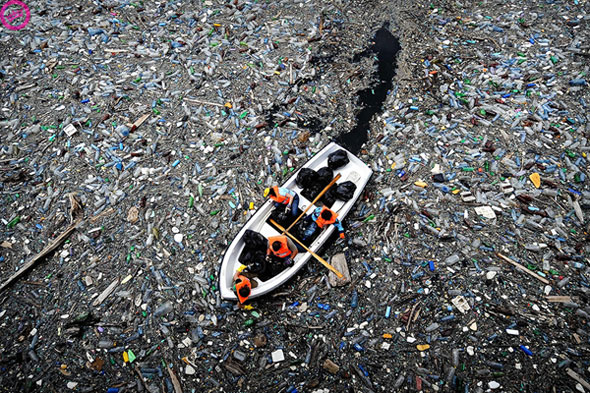
Krichim, Boat in plastic, April 25, 2009. Photo: Dimitar Dilkoff
Marine Debris
The term marine debris has been used for at least 25 years to refer
to man-made materials that have been discarded or lost into the ocean.
The earliest references come from the 1984 Workshop on the Impacts and
Fate of Marine Debris (Shomura and Yoshida 1985). This workshop came out
of a 1982 request from the Marine Mammal Commission to the National
Marine Fisheries Service to examine the impacts of marine debris. At
that time, the focus of research was primarily on derelict fishing gear.
Keep in mind that this was prior to the implementation of both the
high-seas driftnet ban and MARPOL Annex V.
Other terms used prior to 1984 include the following: man-made
debris (Feder et all 1978), synthetic debris (Balazs 1979), plastic
litter (Merrell 1980), floating plastic debris (Morris 1980), man-made
objects (Shaughnessy 1980, Venrick et al 1973), and debris (Scordino and
Fisher 1983).
It would appear that the term debris was being used in these articles by academics as something discarded: litter.
The term marine debris encompasses more than plastic, including
metals (derelict vessels, dumped vehicles, beverage containers), glass
(light bulbs, beverage containers, older fishing floats), and other
materials (rubber, textiles, lumber). Plastic certainly makes up the
majority of floating litter, but in some areas the debris on the ocean
floor may contain sizeable amounts of those other denser types.
Scientists have similarly and more simply defined marine debris as,
any manufactured or processed solid waste material that enters the ocean
environment from any source (Coe & Rogers, 1997). Marine debris is
definitely characterized as human-created waste that has deliberately or
accidentally become afloat. They tend to accumulate at the centre of
gyres and on coastlines, frequently washing aground where it is known as
beach litter.
The US Congress passed a bill in 2006, The Marine Debris Research,
Prevention, and Reduction Act, to create a program to address the marine
debris pollution. One of the requirements in the bill was for NOAA
(National Oceanic and Atmospheric Administration) and the U.S. Coast
Guard, to promulgate a definition of marine debris for the purposes of
the Act. Thus, USCG and NOAA drafted and published a definition of
marine debris in September 2009.
The definition is this: “Any persistent
solid material that is manufactured or processed and directly or
indirectly, intentionally or unintentionally, disposed of or abandoned
into the marine environment or the Great Lakes.” Marine debris can come
in many forms, from a plastic soda bottle to a derelict vessel. Types
and components of marine debris include plastics, glass, metal,
Styrofoam, rubber, derelict fishing gear, and derelict vessels.
UNEP has defined marine debris, or marine litter, as “any
persistent, manufactured, processed, or solid material discarded,
disposed of, or abandoned in the marine and coastal environment.” This
is an even more global and comprehensive definition, as it does include
the marine and correlated coastal impact of the aforementioned litter.
As we mentioned supra, land-based sources of debris account for up
to 80 percent of the world’s marine pollution. Such debris is
unquestionably one of the world’s most pervasive pollution problems
affecting our beaches, coasts, oceans, seafloors, inland waterways and
lands. It affects the economies and inhabitants of coastal and waterside
communities worldwide.
The effect of coastal littering is obviously
compounded by vectors, such as rivers and storm drains, discharging
litter from inland urban areas. Obviously, ocean current patterns,
climate and tides, and proximity to urban centers, industrial and
recreational areas, shipping lanes, and commercial fishing grounds
influence the types and amount of debris that is found in the open ocean
or collected along beaches, coasts and waterways, above and below the
water’s edge.
The other 20 percent of this debris is from dumping activities on
the water, including vessels (from small power and sailboats to large
transport ships carrying people and goods), offshore drilling rigs and
platforms, and fishing piers.
Over the past 60 years, organic materials, once the most common form
of debris, have yielded to synthetic elements as the most abundant
material in solid waste. Marine litter is now 60 to 80 percent plastic,
reaching 95 percent in some areas, according to a report by the Algalita
Marine Research Foundation (created by Charles Moore), published in
October 2008 in
Environmental Research.
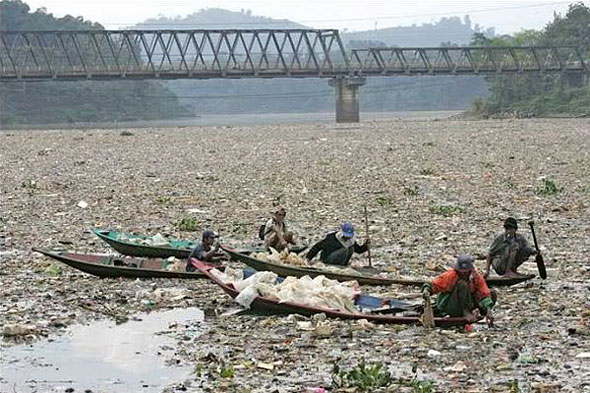
Citarum River, flowing to the Sea, is the main source of houselhold
water for Jakarta.(14million people). Photo source: photobucket
Around and around, worldwide, at distant seas, or merely bobbing
among the waves before washing up ultimately on shore, a daily and ever
too common plastic spectacle is unveiled: bottles, plastic bags,
fishnets, clothing, lighters, tires, polystyrene, containers, plastics
shoes, just a myriad of man-made items, all sharing a common origin: us.
Yearly data adds to the despondent reality of how extensively the
plastic tide is increasingly affecting world’s beaches and coasts.
Launched in 1986 by the Ocean Conservancy, the Center for Marine
Conservation’s annual International Coastal Cleanup (ICC) has grown into
the world’s largest volunteer effort to collect data on the marine
environment.
Held the third Saturday of each September, the
International Coastal Cleanup engages the public to remove trash and
debris from the coasts, beaches, waterways, underwater, and on lands to
identify the sources of debris. It is a compelling global snapshot of
marine debris collected on one day at thousands of sites all over the
world.
The 2008, 23rd ICC reported that 104 countries and locations,
from Bahrain to Bangladesh, and in 42 US States, from southern
California to the rocky coast of Maine, had participated. The
overwhelming percentage of debris collected was plastics and smoking
paraphernalia. The 2008 report states that plastic litter has increased
by 126 percent since ICC first survey in 1994. The top 3 items found in
2008 were cigarettes butts, plastic bags, and food wrappers/containers.
Durable and slow to degrade, plastic materials that are used in the
production of so many products, from containers for beverage bottles,
packing straps and tarps, and synthetic nylon materials used in fishing
line, all become debris with staying power. Plastics debris accumulates
because it does not biodegrade as many other substances do; although it
will photo degrade on exposure to sunlight and does decompose, more
rapidly than previously thought. (We will explain these processes as we
study the nature and properties of plastic itself infra.).
In addition, most of these plastic waste items are highly buoyant,
allowing them to travel in currents for thousands of miles, endangering
marine ecosystems and wildlife along the way. Marine debris is a global
transboundary pollution problem.
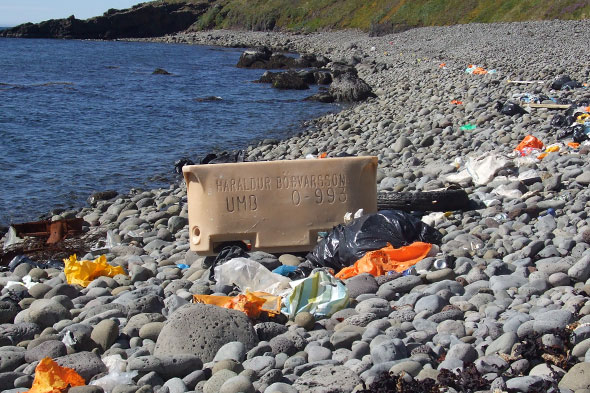
Icelandic shore. The marine area around Iceland is considered as one
of the cleanest of the world. Photo Source: Clean up the Coastline,
Veraldarvinir
The instillation of plastic in an oceanic world vests a terrible
reality. Because of the properties of plastic as a synthetic material
and because of the absence of boundary, vastness, currents and winds at
seas, this resilient polluting material is being spread worldwide by an
even more powerful vehicle, the seas. It appears then daunting,
impossible, a priori, to control, efficiently clean-up, remedy
effectively, even sufficiently study the plastic pollution. This
unwilling confrontation of titans, one plastic the other oceanic, has
become ineluctably a crisis of massive proportion.
Plastic
The paucity of concerted and definitive scientific data/research in
this matter is staggering compared to the extent of the problem.
Only in 1997, with Captain Charles Moore’s discovery, was the plastic
waste pollution in the ocean widely brought to media light and finally
began to receive more serious attention from the public and the
scientific world, stepping the way to more exhaustive research about
plastic and its consequences and effects when entering marine life.
Of the 260 million tons of plastic the world produces each year,
about 10 percent ends up in the Ocean, according to a Greenpeace report
(Plastic Debris in the World’s Oceans, 2006). Seventy percent of the
mass eventually sinks, damaging life on the seabed. The rest floats in
open seas, often ending up in gyres, circular motion of currents,
forming conglomerations of swirling plastic trash called garbage
patches, or ultimately ending up washed ashore on someone’s beach.
But the washed up or floating plastic pollution is a lot more than
an eyesore or a choking/entanglement hazard for marine animals or birds.
Once plastic debris enters the water, it becomes one of the most
pervasive problems because of plastic’s inherent properties: buoyancy,
durability (slow photo degradation), propensity to absorb waterborne
pollutants, its ability to get fragmented in microscopic pieces, and
more importantly, its proven possibility to decompose, leaching toxic
Bisphenol A (BPA) and other toxins in the seawater.
“Plastics are a contaminant that goes beyond the visual”, says Bill Henry of the Long Marine Laboratory, UCSC.

Seal trapped in plastic pollution. Photo:
©© Tedxgp2
But before we develop further the realities and consequences of the
plastic-covered beaches, seafloor and plastic-instilled seawater, it is
necessary to present simple facts about plastic itself.
Facts About Plastic
What is plastic?
A simple definition could be: any of a group of synthetic or natural
organic materials that may be shaped when soft and then hardened,
including many types of resins, resinoids, polymers, cellulose
derivatives, casein materials, and proteins: used in place of other
materials, as glass, wood, and metals, in construction and decoration,
for making many articles, as coatings, and, drawn into filaments, for
weaving. They are often known by trademark names, as Bakelite, Vinylite,
or Lucite.
In chemistry, plastics are large molecules, called polymers,
composed of repeated segments, called monomers, with carbon backbones. A
polymer is simply a very large molecule made up of many smaller units
joined together, generally end to end, to create a long chain. The
smallest building block of a polymer is called a monomer. Polymers are
divided into two distinct groups: thermoplastics (moldable) and
thermosets (not). The word “plastics” generally applies to the synthetic
products of chemistry.
Alexander Parkes created the first man-made plastic and publicly
demonstrated it at the 1862 Great International Exhibition in London.
The material, called parkesine, was an organic material derived from
cellulose that, once heated, could be molded and retained its shape when
cooled.
Many, but not all, plastic products have a number – the resin
identification code – molded, formed or imprinted in or on the
container, often on the bottom. This system of coding was developed in
1988 by the U.S.-based Society of the Plastics Industry to facilitate
the recycling of post-consumer plastics. It is indeed, quite interesting
to go through the fine lines.
- Polyethylene terephthalate (PET or PETE) – Used in
soft drink, juice, water, beer, mouthwash, peanut butter, salad
dressing, detergent, and cleaner containers. Leaches antimony trioxide
and (2ethylhexyl) phthalate (DEHP).
- DEHP is an endocrine disruptor that mimics the female hormone
estrogen. It has been strongly linked to asthma and allergies in
children. It may cause certain types of cancer and it has been linked to
negative effects on the liver, kidney, spleen, bone formation, and body
weight. In Europe, DEHP has been banned since 1999 from use in plastic
toys for children under the age of three.
- High-density polyethylene (HDPE) – Used in opaque
milk, water, and juice containers, bleach, detergent and shampoo
bottles, garbage bags, yogurt and margarine tubs, and cereal box liners.
Considered a safer plastic. Research on risks associated with this type
of plastic is ongoing.
- Polyvinyl chloride (V or Vinyl or PVC) – Used in
toys, clear food and non-food packaging (e.g., cling wrap), some squeeze
bottles, shampoo bottles, cooking oil and peanut butter jars, detergent
and window cleaner bottles, shower curtains, medical tubing, and
numerous construction products (e.g., pipes, siding). PVC has been
described as one of the most hazardous consumer products ever created.
Leaches di (2-ethylhexyl) phthalate (DEHP) or butyl benzyl phthalate
(BBzP), depending on which is used as the plasticizer or softener
(usually DEHP). DEHP and BBzP are endocrine disruptors mimicking the
female hormone estrogen; have been strongly linked to asthma and
allergic symptoms in children; may cause certain types of cancer; and
linked to negative effects on the liver, kidney, spleen, bone formation,
and body weight. In Europe, DEHP, BBzP, and other dangerous phthalates
have been banned from use in plastic toys for children under three since
1999. Not so elsewhere, including Canada and the United States.
Dioxins are unintentionally, but unavoidably, produced during the
manufacture of materials containing chlorine, including PVC and other
chlorinated plastic feedstocks. Dioxin is a known human carcinogen and
the most potent synthetic carcinogen ever tested in laboratory animals. A
characterization by the National Institute of Standards and Technology
of cancer causing potential evaluated dioxin as over 10,000 times more
potent than the next highest chemical (diethanol amine), half a million
times more than arsenic, and a million or more times greater than all
others.
- Low-density polyethylene (LDPE) – Used in grocery
store, dry cleaning, bread and frozen food bags, most plastic wraps, and
squeezable bottles (honey, mustard). Considered a safer plastic.
Research on risks associated with this type of plastic is ongoing.
- Polypropylene (PP) – Used in ketchup bottles,
yogurt and margarine tubs, medicine and syrup bottles, straws, and
Rubbermaid and other opaque plastic containers, including baby bottles.
Considered a safer plastic. Research on risks associated with this type
of plastic is ongoing.
- Polystyrene (PS) – Used in Styrofoam containers,
egg cartons, disposable cups and bowls, take-out food containers,
plastic cutlery, and compact disc cases. Leaches styrene, an endocrine
disruptor mimicking the female hormone estrogen, and thus has the
potential to cause reproductive and developmental problems. Long-term
exposure by workers has shown brain and nervous system effects and
adverse effects on red blood cells, liver, kidneys, and stomach in
animal studies. Also present in secondhand cigarette smoke, off gassing
of building materials, car exhaust, and possibly drinking water. Styrene
migrates significantly from polystyrene containers into the container’s
contents when oily foods are heated in such containers.
- Other – This is a catchall category that includes
anything that does not come within the other six categories. As such,
one must be careful in interpreting this category because it includes
polycarbonate – a dangerous plastic – but it also includes the new,
safer, biodegradable bio-based plastics made from renewable resources
such as corn and potato starch and sugar cane. Polycarbonate is used in
many plastic baby bottles, clear plastic sippy cups, sports water
bottles, three and five gallon large water storage containers, metal
food can liners, some juice and ketchup containers, compact discs, cell
phones, computers. Polycarbonate leaches Bisphenol A (some effects
described above) and numerous studies have indicated a wide array of
possible adverse effects from low-level exposure to Bisphenol A:
chromosome damage in female ovaries, decreased sperm production in
males, early onset of puberty, various behavioral changes, altered
immune function, and sex reversal in frogs.
Rob Krebs of the American Plastics Council notes that people value
plastics for exactly what creates the most problems at sea and on lands:
their durability.
Plastic debris, of all sizes and shapes, is a transboundary pollution problem with a powerful vehicle, the ocean.

Vacha Dam near town of Krichim, April 25, 2009. Photo: Dimitar Dilkoff
Buoyancy
Plastics travel long distances. Their distribution in the oceans
isn’t uniform, yet they are omnipresent from the Polar Regions to the
Equator. Scientists are still refining methods to detect and analyze the
materials. A good example of plastic debris’ buoyancy is as follows. In
1992, twenty containers full of rubber ducks were lost overboard from a
ship traveling from China to Seattle. By 1994, some had been tracked to
Alaska, while others reached Iceland in 2000. The ducks (with a
distinctive logo on their base) have been sighted in the Arctic, Pacific
and Atlantic Oceans (Ebbesmeyer, 2003).
Photodegradation Vs. Biodegradation
Plastic is generally a durable material. Its durability has made the
culprit of the problem since it is considered resistant to natural
biodegradation processes, i.e. the microbes that break down other
substances do not recognize plastic as food. Yet plastic can be
fragmented with the effects of UV, being broken down by light in smaller
and smaller debris over time.
Biodegradation, the breaking down of organic substances by natural
means, happens all the time in nature. All plant-based, animal-based, or
natural mineral-based substances will over time biodegrade. In its
natural state raw crude oil will biodegrade, but man-made petrochemical
compounds made from oil, such as plastic, will not. Why not? Because
plastic is a combination of elements extracted from crude oil then
re-mixed up by men in white coats. Because these combinations are man
made they are unknown to nature. Consequently, it has been thought that
there is no natural system to break them down. The enzymes and the micro
organisms responsible for breaking down organic materials that occur
naturally such as plants, dead animals, rocks and minerals, don’t
recognize them. This means that plastic products are said
indestructible, in a biodegradable sense at least.
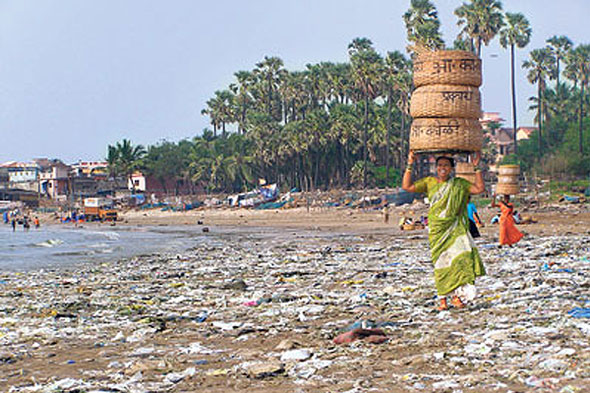
Indian Beach, Manori. Photo Source: Malad Bolivari.
In sum, as time passes, we know that plastic will eventually
photo-degrade, i.e. break down into smaller and smaller fragments by
exposure to the sun. The photo-degradation process continues down to the
molecular level, yet photo-degraded plastic remains a polymer. No
matter how small the pieces, they are still and always will be plastic,
i.e. they are not absorbed into or changed by natural processes. At sea,
the plastic fragmentation process occurs as well, due to wave, sand
action, and oxidation. Estimates for plastic degradation at sea has been
ranged from 450 to 1,000 years.
Of particular concern are the floating small plastic fragments often
referred in the media to as mermaids’ tears, which are tiny nurdles of
raw plastic resin that form the building material of every manufactured
plastic product, or are granules of domestic waste that have fragmented
over the years. Dr Richard Thompson of the University of Plymouth, UK
has identified plastic particles thinner than the diameter of a human
hair. But while they cannot be seen, those pieces are still there and
are still plastic. Not absorbed into the natural system, they just float
around within it. He estimates that there are 100,000 particles of
plastic per sq km of seabed and 300,000 items of plastic per sq km of
sea surface.
Either way, mermaid tears, or fragmented plastic debris, reaching
microscopic size over time, remain everywhere and are almost impossible
to clean up. They are light enough to float in the wind, landing in the
earth’s oceans. Mermaid’s tears are often found in filter feeders like
mussels, barnacle, lugworm and amphipods.
Thus, the photo degradation of plastic debris makes the matter
worse. Plastic becomes microscopic, invisible, yet ever polluting
waters, beaches, coasts, seafloor, being eaten by even tinier marine
organisms, therefore entering the food chain insidiously and
ineluctably.
Toxic Sponge
Corroborating reports and findings worldwide demonstrated that
fragmented plastics debris’ increase and massive presence on and off
shores does constitute reason for raised worries and awareness.
Studies on small plastic pellet by Dr Richard Thompson and by
Hideshige Takada, Yukie Mato professor of organic geochemistry at Tokyo
University, have shown that plastic debris meeting other pollutants in
the oceans absorbs harmful chemicals from the sea water they float in,
acting like a pollution sponges.
These studies have been conducted on plastic nurdles not just
because of their uniform size and shape, thus easier to study and
compare by scientifics, but also because of their wide spread presence
on the world’s beaches.
In UK, mermaid tears are the second common plastic litter found on
the beaches according to the Marine Conservation Society’s 2007 data and
a Surfers Against Sewage (SAS) report.
According to Charles Moore, these resin pellets account for around 8
percent of annual oil production and are the raw material for the 260
million tons of plastic consumed yearly worldwide. Lightweight and
small, they escape in untold volumes during transport and manufacture
and wash in the ocean.
Even though these researches have been conducted on nurdles, it is
crucial to keep in mind, as Dr. Takada team confirmed, that other types
of plastic debris (from fishing gear, shopping bags, to small fragments)
displays the exact same propensity as the nurdles of raw plastic resin
to absorb toxins.
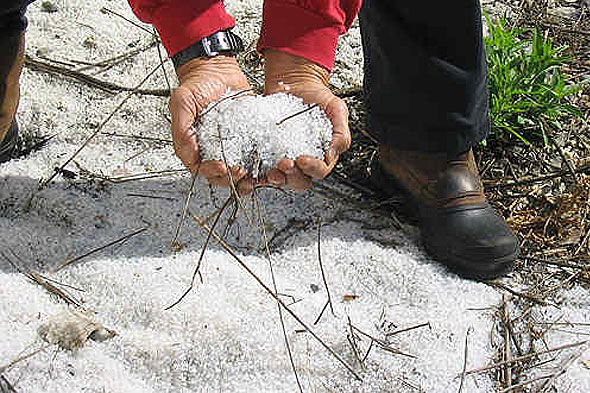
Nurdles covered beach. Photo Source: Algalita Foundation
Plastic resin pellets are round, shiny and tiny, mostly less than
5mm in diameter. The very structure of the plastic material is oily and
greasy (basically plastics are solid oil) therefore promoting the
accumulation of hydrophobic contaminants (ones that tend to repel and
not absorb water) from the surrounding seawater. Chemicals like PCB’s
and DDE are very hydrophobic.
It was shown that plastic pellets suck up
these dangerous persistent organic pollutants (POPs) and toxins with a
concentration factor that’s almost 1 million times greater compared to
the overall concentration of the chemicals in seawater. In other words,
waterborne hydrophobic pollutants do collect and magnify on the surface
of plastic debris, thus making plastic far more deadly in the ocean than
it would be on land.
These findings, published in the
Marine Pollution Bulletin,
were based on samples gathered from 30 beaches in 17 countries. PCB
(Polychlorinated biphenyls) pollutant concentrations on plastic pellet
were highest on US coasts, followed by Western Europe and Japan. The
highest concentrations of DDT (Dichlorodiphenyltrichloroethane), the
most toxic of all pesticides, were found on the US west coast and
Vietnam.
Plastic marine debris, thought to be “indestructible”, “lasting
forever”, has been shown to decompose faster than previously thought,
under unexpected conditions (in the water and at sea temperature) and,
most importantly, releasing toxic substances not found in the natural
element: seawater.
Decompose
Since plastics belong to a chemical family of high polymers, they
are essentially made up of a long chain of molecules containing repeated
units of carbon atoms. Because of this inherent molecular stability
(high molecular weight), plastics do not easily breakdown into simpler
components.

North America, touched landscape. Photo Source: photobucket
Plastics do decompose, though not fully, over a very long period of
time (in average 100 to 500 years). Commercially available plastics
(polyolefins like polyethylene, polypropylene, etc.) have been further
made resistant to decomposition by means of additional stabilizers like
antioxidants. Thus, unless the plastic is specially designed to
decompose in the soil, such materials can last a very long time because
the chemical bonds that hold the molecules together are often stronger
than nature’s power to take them apart. This means that soil
microorganisms that can easily attack and decompose things like wood and
other formerly living materials cannot break the various kinds of
strong bonds that are common to most plastics. This depends upon the
plastic (polymer) and the environment to which it is exposed.
The Marine Conservancy has published that the estimated decomposition rates of most plastic debris found on coasts are:
- Foamed plastic cups: 50 years
- Plastic beverage holder: 400 years
- Disposable diapers: 450 year
- Plastic bottle: 450
- Fishing line: 600 years.
Until Dr. Saido’s report, no studies had been conducted on plastic
decomposition at low temperature in the marine environment, owing to the
mistaken conception that plastic does practically not decompose in such
condition. In the first study to look at what happens over the years to
the billions of pounds of plastic waste drifting in the world’s oceans,
researchers, lead by Katsuhiko Saido, PhD, reported that plastic does
“decompose with surprising speed (as little as a year) and release
potentially toxic substances into the water.”
These findings were reported on August 19, 2009, at the 238th
National Meeting of the American Chemical Society (ACS). The scientists
there termed the discovery “surprising.”
Dr. Saido described a new method to simulate the breakdown of
plastic products at low temperatures (30º Celsius, 86º F), such as those
found in some oceans. David Barnes, marine ecologist from the British
Antarctic Survey, expressed that the Japanese’s team lab results cannot
be applied uniformly across the ocean. However, even though the
decomposition process would not occur in much cooler seawater as Barnes
mentioned, the oceans are vast, currents are constant and permanent,
nothing stays static and furthermore, it seems that garbage patches
where plastics accumulate, are to be found in even greater dimension in
the South Gyres, in the tropical and sub tropical zones with very warm
waters. One of the researchers stated: “Even at 30 degrees Celsius, the
plastic decomposes. In natural conditions, the tide comes in and
sunlight heats the plastics [which increases decomposition].”
The type of plastic studied by Saido’s team was polystyrene, a white foamed plastic, commonly known by the trademark Styrofoam.
The process involved modeling plastic decomposition at room
temperature, removing heat from the plastic and then using a liquid to
extract the BPA and PS Oligomer that are not found naturally, thus must
have been created through the decomposition of the plastic. Once
degraded, the plastic was shown to release three new compounds not found
in nature: styrene monomer (SM), styrene dimer (SD) and styrene trimer
(ST). While SM is already a known carcinogen, SD and ST are suspected to
be as well.
Plastics are not metabolized subsequent to ingestion since they are
polymers. On the other hand, low molecular compounds such as PS oligomer
or BPA from plastic decomposition are toxic and can be metabolized!
Samples of sea sand and seawater collected from Europe, India, Japan
and the Pacific Ocean were found to be contaminated, with up to 150
parts per million of some of these components of plastic decomposition.
“Plastics in daily use are generally assumed to be quite stable,” said
study lead researcher Katsuhiko Saido, Ph.D. “We found that plastic in
the ocean actually decomposes as it is exposed to the rain and sun and
other environmental conditions, giving rise to yet another source of
global contamination that will continue into the future.”
This latest study clearly shows new micro-pollution by compounds
generated by plastic decomposition to be taking place out of sight in
the ocean, leaching toxic chemicals such as Bisphenol A (BPA) and
derivatives of polystyrene.
Even though present in seawater and sands, the pollutants are found
in highest concentration in areas heavily littered with plastic debris,
such as ocean vortices, which bring us to define more specifically the
notion of gyres and “garbage patches”.
Gyres and Garbage Patches
The plastic litter defacing the beaches of the World, alarming in
Hawaiian archipelagos for instance, led, only two decades ago, a couple
of private and public teams of environmentalists and scientists to start
conducting research regarding marine debris in the oceans.
Between 1985 and 1988, an Alaska- based team of researchers found
high concentrations of marine debris accumulating in regions governed by
vortices like pattern of ocean currents, which lead the National
Oceanic and Atmospheric Administration (NOAA) of the United States to
publish a paper, in 1988, mentioning the high probability of the
existence of “a large area highly concentrating plastic waste debris in
the North Pacific”.
Flyovers of the area have been conducted as well,
but not in a conclusive way. The trash was not that obvious from the
sky. Indeed, despite its size and density, the GGP is not visible from
satellite photography because of its consistency, as Kaisei project and
Scripps teams confirmed last August. The largest mass of the plastic
pollution contains fragmented pieces of plastic, permeating the ocean,
almost invisible to the naked eye, suspended at, or beneath the surface
of the ocean.

Plastic soup. Photo: Charles Moore
As evoked above, Charles Moore, a Californian sailor, surfer,
volunteer environmentalist, and researcher, was crossing the Pacific
Ocean while returning from a trans Pacific sailing race in 1997. He
veered from the usual sea route taking a shortcut across the edge of the
North Pacific Ocean.
He came upon an area, the Doldrums, a windless
part of the ocean that mariners usually avoid. The area is filled with
tiny phytoplankton, but few big fish or mammals, thus fishermen and
sailors rarely travel through it. There, Charles Moore saw an ocean he
had never known. Every time he stepped out on deck, “there were shampoo
caps and soap bottles and plastic bags and fishing floats as far as I
could see. Here I was in the middle of the ocean, and there was nowhere I
could go to avoid the plastic.”
This area that Charles Moore came upon, the North Pacific
Subtropical Gyre, is a slowly moving, clockwise spiral or vortex of
currents created by a high-pressure system of air currents. He reported
his find to Curtis Ebbesmeyer, an oceanographer, who named it the
Eastern Garbage Patch.
Shocked by the extent of the plastic litter, Charles Moore went on alerting the world to the existence of this phenomenon.
Moore’s discovery was finally corroborating previous scientists’s,
suspicions and extrapolations in regard to the existence of a high
debris concentration in stable bodies of oceanic waters created over
time by the rotating ring-like ocean currents system called gyres.
“We were out in the middle of the Pacific, where you would think the
ocean would be pristine,” recalls the Alguita’s captain, Charles Moore.
“…And instead, we get the Exxon Valdez of plastic-bag spills.”
Captain Moore’s giant floating debris field’s discovery has since
been subject to other expeditions, and another “patch” was found further
west.
Media light was finally brought in force at that point. Human kind
has walked on the moon since 1969…yet the ocean was still quite an
unknown frontier in our collective conscience.
Gyres
The North Pacific gyre has given birth to two large masses of
ever-accumulating plastic debris, known as the Western and Eastern
Pacific Garbage Patches, collectively called the Great Pacific Garbage
Patch (GGP). It is a gyre of marine litter in the Central North Pacific
Ocean stretching for hundreds of miles across the ocean 1,000 miles from
California coast on the East, to Japan and Hawaii on the West.
More specifically, a gyre is a large-scale circular feature made up
of ocean currents that spiral around a central point, clockwise in the
Northern Hemisphere and counterclockwise in the Southern Hemisphere.
Gyres make up to 40 percent of the ocean. That is 25 percent of the
globe. All of them are accumulators of debris, Moore says.
Worldwide, there are five major subtropical oceanic gyres: the North
and South Pacific Subtropical Gyres, the North and South Atlantic
Subtropical Gyres, and the Indian Ocean Subtropical Gyre. Since each
behaves in the same vortex style, scientists are certain that massive
conglomerates of marine litter like the North Pacific Garbage Patch
exist in each of the world’s oceans. That is soberingly
self-explanatory: such huge garbage patch, or even larger ones, are more
than likely to be discovered in the near future.
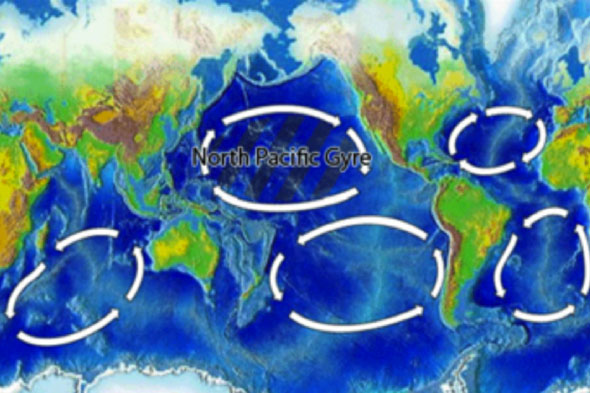
North Pacific Gyre. Illustration: NOAA
It is very difficult to measure the exact size of a gyre because it
is a fluid system, but the North Pacific Subtropical Gyre is roughly
estimated to be approximately 7 to 9 million square miles, approximately
three times the area of the continental United States (3 million square
miles). Gyres do potentially aggregate debris on that large a scale.
That is titanic.
Upon returning from their 22 days venture on the GGP, Project Kaisei
and Scripps scientists’ stated in a press conference held in September
2009: “(we) hope our data gives clues as to the density and extent of
marine plastic debris, especially since the Great Pacific Garbage Patch
may have company in the Southern Hemisphere, where scientists say the
gyre is four times bigger. “We’re afraid at what we’re going to find in
the South Gyre, but we’ve got to go there,” said Tony Haymet, director
of the Scripps Institution.
Garbage Patches
The Great Garbage patch is two separate accumulations connected by a
6,000-mile marine litter “corridor” known as the North Pacific
Convergence Zone (STCZ). As will be explained infra, the convergence
zone is in itself another serious accumulator of traveling plastic
debris.
The Eastern Pacific Garbage Patch floats between Japan and Hawaii;
the Western Patch floats between Hawaii and California. The rotational
pattern created by the North Pacific Gyre draws in waste material from
as far as Asia to the USA. As material is captured in the currents,
wind-driven surface currents gradually move floating debris inward,
trapping debris in higher concentrations in the calm center. Ocean
currents carry debris from the East coast of Asia to the center, in less
than a year, and from the Western US in about 5 years.

North Pacific Subtropical Gyre. Illustration: Greenpeace
NOAA has tracked the Great Pacific Garbage Patch movements to some
degree. It is not a stationary area, but one that moves and changes as
much as a thousand miles north and south, and during warmer ocean
periods, known as El Nino, it drifts even further south. The movements
occur because the North Pacific Gyre is made up of four different
currents: the North Pacific Current to the north; the California Current
to the west; the North Equatorial Current to the south; and the
Kuroshio Current to the east. This movement sometimes brings the Western
Garbage Patch within 500 nautical miles of the California coast and
causes extraordinary massive debris pile-ups on beaches, such as in the
Hawaiian Islands and Japan.
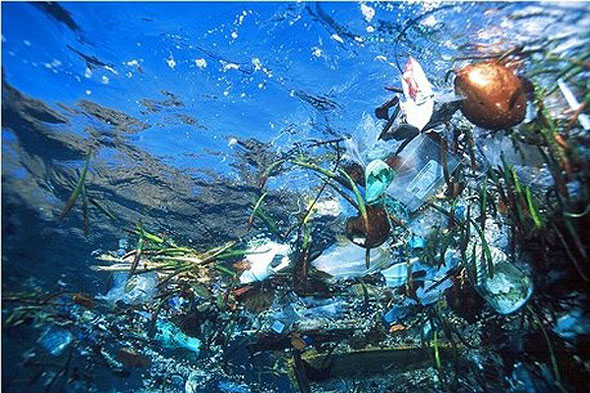
Great Garbage patch, floating debris. Photo Source: flyaddicts
The name garbage patch has led many to believe that this area is a
large and continuous patch of easily visible marine debris items, such
as bottles and other litter, akin to a literal blanket of trash that
should be visible with satellite or aerial photographs. This is simply
not true. While larger litter items can be found in this area, along
with other debris such as derelict fishing nets, the largest mass of the
debris is small bits of floatable plastic.
We cannot emphasize enough that the GGP is now characterized by
extremely high concentrations of suspended plastic debris for 90
percent, basically a soupy mix of plastic-filled seawater, made of tiny
plastic debris that have been trapped by the currents and stretching for
maybe thousands of miles, and that is the great problem.
Indeed, the researchers from Project Kaisei and the Scripps
Environmental Accumulation of Plastic Expedition (SEAPLEX), after their
journey through the area, collecting samples the whole way, reported:
“All we could see, not at first glance but with magnifying glass and
magnifying worries, for miles and miles, was an incredibly huge mass of
confetti-like tiny mermaid tears, plastic fragments, floating just
beneath the surface. ” As one of the scientist from the Project Kaisei
witnessed: “There’s no island, there’s no eighth continent ” Miriam
Goldstein said, “It doesn’t look like a garbage dump. It looks like
beautiful ocean. But then when you put the nets in the water, you see
all the little pieces.” And while the expedition covered 1,700 miles,
members of the Kaisei team say the patch could be much, much larger…
As for its depth and assumed density, the scientists reported that
the GGP’s waters were just clogged with plastic particles to a depth of
10 meters below the surface. The Scripps/ Kaisei survey mission of the
gyre found that plastic debris was present in 100 consecutive samples
taken at varying depths and net sizes.
In sum, they estimated the patch area ranged in size from 700,00 km2
to more than 15 million km2; the area may contain over 100 million tons
of plastic debris.
Already in 1999, a study by Charles Moore, sampling waters from the
GGP, found that the concentrations of plastic there reached one million
particles per square mile, topping the concentration of zooplankton
(plankton consisting of small animals and the immature stages of larger
animals) by a factor of six. In 2008, the published new research from
the Algalita foundation team of scientists estimated that the number had
doubled.
After the return of the two vessels from Project Kasei and Scripps (Seaplex),
Kaisei and
New Horizon,
the only certainty was that the size of the Great Pacific Garbage Patch
remains uncertain. “It’s not a hard and fast number.” There has been
extensive media coverage about the garbage patch over the past couple
years; however, its reported size and mass have differed from news
article to article. “It’s a little bit like a whirlpool on the surface
of a river or a lake. You’d be hard-pressed to tell me where the edge
is. All you know is that it’s stronger in the middle than it is in the
outer reaches. But it’s an area of many hundreds of miles, perhaps
thousands, in which the ocean currents tend to bring it together,”
according to Robert Knox, deputy director for research at the Scripps
Institution.
In the summer of 2010, Project Kaisei will launch its second
expedition to the North Pacific Gyre where it will send multiple vessels
to continue marine debris research and, in particular, to test an array
of larger marine debris collection systems.

Marine debris collection at the GGP. Photo: Lindsey Hoshaw
The Eastern Garbage Patch has been studied the most so far, yet it
is not and obviously cannot be the only vast oceanic “rubbish dump out
there” says Charles Moore. The GGP is definitely not the only type of
area where marine debris concentrates. Several other features within the
ocean, including oceanic eddies and convergence zones, can lead to
debris accumulation as well.
A great and well known example is the North
Pacific Subtropical Convergence Zone (STCZ). It is located along the
southern edge of an area known as the North Pacific Transition Zone.
NOAA has focused on the STCZ because it is an area triggering massive
debris accumulation in Hawaii. This area does not have distinct
boundaries and varies in location and intensity of convergence
throughout the year. This zone moves seasonally between 30º and 42º N
latitude (approximately 800 miles), extending farther south (28ºN)
during periods of El Niño (Donohue and Foley, 2007).
The August 2009 expedition was so dauntingly successful and the
findings were so”shocking”, that “…Scripps’ officials are now working to
raise funds for a trip to the South Pacific gyre, sometime within the
next two years”, Haymet announced at a press conference last August.
“That project’s scope is far greater. While the North Pacific patch
appeared as large as the Continental US, its South Pacific cousin is
suspected to be about four times as large”, roughly the size of all of
Western and part Eastern Europe.
II: The Path To Successful Resolution
This unprecedented plastic waste tide appears as vast as the ocean,
as ungraspable as the unfathomable mass of microscopic plastic
fragments present at sea, transported by winds and currents, yet,
ultimately, the plastic tide can become as limited as our chosen
relationship with plastics, which involves a dramatic behavioral change
on our part. The path to successful resolution of the crisis clearly
appears…as we are the problem and the solution.
The Victims and The Aggressors
The despondent effects and too numerous casualties of the great
plastic tide are visible, but more alarmingly, beyond visual, which
ought to prompt the perpetrators to choose no other path than the
advocacy and culture of consistent and sustained behavioral changes.
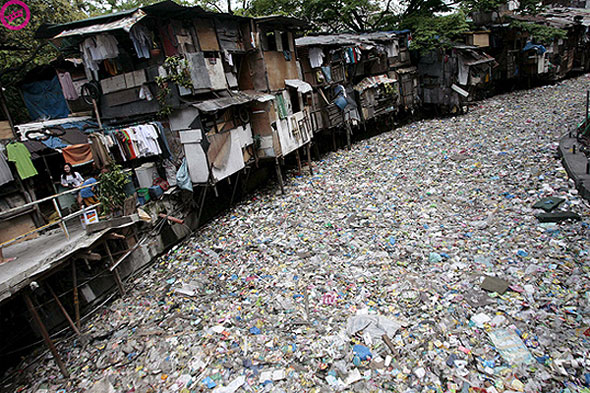
Creek in Manilla, Philippines, March 01 2009. Photo: Francis R. Malasig
The Victims
Animals
From the whale, sea lions, and birds to the microscopic organisms
called zooplankton, plastic has been, and is, greatly affecting marine
life, i.e animals on shore and off shore, whether by ingestion or
entanglement.
In a 2006 report,
Plastic Debris in the World’s Oceans,
Greenpeace stated that at least 267 different species are known to have
suffered from entanglement and ingestion of plastic debris. The National
Oceanographic and Atmospheric Administration said that plastic debris
kills an estimated 100,000 marine mammals annually, millions of birds
and fishes.
The largest pieces of marine plastic debris, miles long discarded
fishing nets and lines mostly, take an obvious toll on animals. These
derelicts nets, called ghost nets, snare and drown thousands of larger
sea creatures per year, such as seals, sea lions, dolphins, sea turtles,
sharks, dugons, crocodiles, seabirds, crabs, and other creatures.
Acting as designed, these nets restrict movement causing starvation,
laceration, infection, and, in animals that need to return to the
surface to breathe, suffocation.

Entangled seal by derelict net, Hawaii. Photo Source: NOAA
On shores, researchers have also watched in horror as hungry
turtles wolf down jellyfish-like plastic bags and seabirds mistake old
lighters and toothbrushes for fish, choking when they try to regurgitate
the plastic trash for their starving chicks.
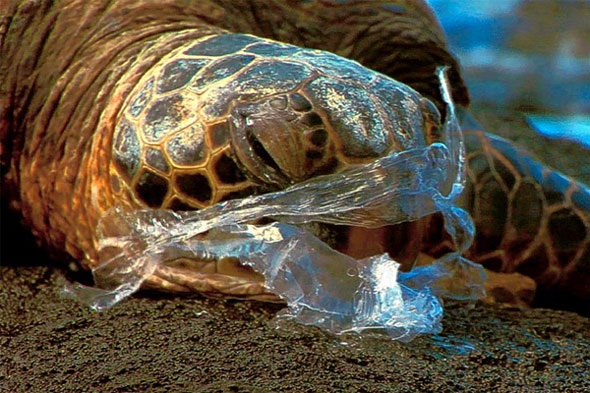
Turtle eats plastic. Photo Source: Greenhouse Carbon Neutral Fdn
In the waters, plastic bags specifically, can be mistaken as food
and consumed by a wide range of marine species, especially those that
consume jellyfish or squid, which look similar when floating in the
water column.
Albatross and others birds are choosing plastic pieces because of
their similarity to their own food as well. Captain Moore and his
Alguita team did see, above the GGP, albatrosses and tropicbirds
circling above the line of trash. With little else to choose, they were
obviously eating plastic. The birds seemed to be picking and choosing
“the reds and pinks and browns. Anything that looks like shrimp,” Moore
says. Earlier in the trip, the Alguita had visited the French Frigate
Shoals, off Hawaii, home to endangered monk seals and seabird rookeries.
In the birds’ gullets researchers found red plastic particles.
Greenpeace reported that a staggering 80 percent of seabird populations
observed worldwide have ingested plastics. Research into the stomach
contents of dead Fulmars from the Netherlands, between 1982 and 2001,
found that 96 percent of the birds had plastic fragments in their
stomachs with an average of 23 plastic pieces per bird (Van Franeker and
Meijboom, 2003).

Midway atoll, bird corpse. Photo: Chris Jordan
When plastic ingestion occurs, it blocks the digestive tract, gets
lodged in animals windpipes cutting airflow causing suffocation, or
fills the stomach, resulting in malnutrition, starvation and potentially
death. Indeed, it is found that debris often accumulates in the
animals’ gut and give a false sense of fullness, causing the animal to
stop eating and slowly starve to death.

Midway atoll, bird corpse. Photo: Chris Jordan
In April 2002 a dead Minke whale washed up on the Normandy coast in
France. An investigation found that its stomach contained 800 kg of
plastic bags (GECC, Groupe d’Etude des Cétacés du Cotentin, 2002).
In February 2004, a Cuviers Beaked whale (Ziphius cavirostris) was
found washed ashore on the west coast of the Isle of Mull, Scotland.
Cuviers beaked whales are rarely seen in coastal waters, as they are
predominantly a deep-water species. The Hebridean Whale and Dolphin
Trust took various skin and blubber samples and removed the stomach for
further study by the Scottish Agricultural College. On initial removal
it was found that the entrance to the stomach was completely blocked
with a cylinder of tightly packed shredded black plastic bin liner bags
and fishing twine. It is believed that this made it difficult for the
animal to forage and feed effectively.
50 to 80 percent of sea turtles found dead are known to have ingested plastic marine debris.
The smaller the pieces of plastic get, the more dangerous they are
to marine organisms. Fragmented plastic, specifically nurdles and small
size mermaid tears, are found in the stomach of smaller sea creatures as
well: fish, birds, marine mammal, reptile, jelly fish, select plastic
pellets as they resemble fish eggs.
Whether the chemicals contained in the plastics are then desorbed
to digestive fluids and transferred to tissues in quantities significant
enough to harm the animals is subject to ongoing, yet still incomplete,
research. However, as more and more studies on the matter are
undergone, unpleasant findings are definitly uncovered.
What is proven, as we’ve seen supra, is that plastic does soak up
pollutants, acting as toxic-sponge for man-made toxins present in the
ocean, thus accumulating pollutants such as polychlorinated biphenyls
(PCBs) and heavy metals at concentrations up to 1 million times higher
than in ocean water (Moore et al, 2001). PCBs can lead to reproductive
disorders, death, an increased risk of disease, and an alteration of
hormone levels (Ryan et al., 1988;Lee et al, 2001). They have been
linked to the masculinisation of female polar bears and spontaneous
abortions and declines in seal populations.
In 1988, Ryan et al obtained
evidence that PCBs in the tissues of Great Shearwaters were derived
from ingested plastic particles (from Derraik, 2002). Furthermore, DDT, a
pesticide that was banned in the US in the 1960′s and labeled by the
Environmental Protection Agency in 1987 as a “probable human
carcinogen,” has been found on these plastics fragments. The most recent
review of all evidence concludes that exposure to DDT before puberty
increases the risk of breast cancer.
Food Chain
In a September press conference, Doug Woodring from Project Kaisei,
said that assessments of the impact of plastic debris on phytoplankton,
zooplankton, and mesopelagic (midwater) fishes are undergoing. The
samples collected from the seawater will be subject to more scientific
studies for the toxicity of the plastics and how this is really
affecting our food chain (in ways that are only just becoming known… and
not good ways).
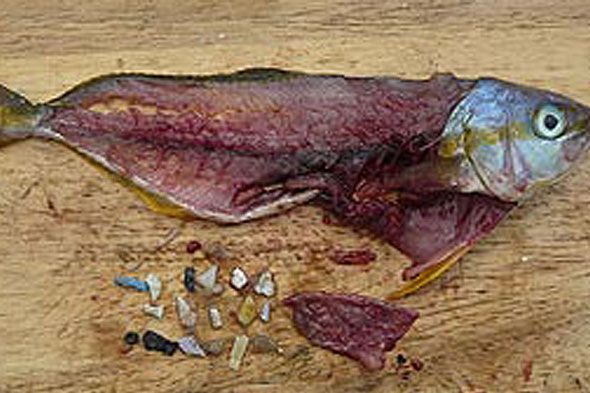
Plastic found in Rainbow Runner fish guts. Photo Source: Algalita Marine Research Foundation
Katsuhiko Saido, Ph.D said, “We found that plastic in the ocean
actually decomposes (…) giving rise to yet another source of global
contamination that will continue into the future.” Furthermore, as Saido
added: “We are concerned that plastic pollution is also caused by these
invisible materials and that it will harm marine life.” While the
potential toxicity of these tiny plastic constituents is still
understudied for much of marine life, plastics are abundant in many
forms. Plastics, including polystyrene, are common in the wads of
accumulated, undigested matter that young black-footed albatrosses cough
up before they fledge.
Whether plastics present a unanimously accepted and proven toxic
challenge to marine life, and subsequently to humans, is one of the
biggest challenges facing scientists right now.
Health
Saido’s latest science report last summer about the decomposition
of polystyrene plastics vests a simple reality: Bisphenol A (BPA) has
been shown and proven to interfere with the reproductive systems of
animals. PS oligomer and BPA from plastic decomposition are toxic and
can be metabolized, while styrene monomer is a suspected carcinogen. Low
levels of BPA and PS oligomer have been proven to cause hormone
disruption in animals.
More scientific reports are being published on the effects of
Bisphenol A on animal and human health, and the news is not good.
In 2009, a professional, international medical organization in the
field of endocrinology and metabolism, The Endocrine Society, reported
data from new research on animals experimentally treated with BPA.
Studies presented at the group’s annual meeting show BPA can affect the
hearts of women, can permanently damage the DNA of mice, and appear to
be entering the human body from a variety of unknown sources. A 2005
study, which analyzed BPA serum concentrations, concluded that “exposure
to BPA is associated with recurrent miscarriage”.
The first major study of health effects on humans associated with
bisphenol A exposure was published in September 2008 by Iain Lang and
colleagues in the Journal of American Association. The cross-sectional
study of almost 1,500 people assessed exposure to bisphenol A by looking
at levels of the chemical in urine. The authors found that higher
bisphenol A levels were significantly associated with heart diseases,
diabetes, and abnormally high levels of certain liver enzymes.
A 2008 scientific review concluded that “prenatal exposure to (…)
low doses of BPA alters breast development and increases breast cancer
risk”. A 2009 scientific review, funded by the “Breast Cancer Fund”, has
recommended “a federal ban on the manufacture, distribution and sale of
consumer products containing bisphenol A”.
A 2009 study on urinary concentrations concluded that prenatal BPA
exposure might be associated with externalizing behaviors in two-year
old children, especially among female children.
A 2009 study on Chinese workers in BPA factories found that workers
were four times more likely to report erectile dysfunction, reduced
sexual desire, and overall dissatisfaction with their sex life than
workers in factories that made products ranging from textiles to
machinery, in which there was no heightened BPA exposure. They were also
more likely to report reduced sexual function within one year of
beginning employment at the factory, and the higher the exposure, the
more likely they were to have sexual difficulties.
A 2009 review of available studies has concluded, “Prenatal BPA
exposure acts to exert persistent effects on body weight and adiposity.”
A 2009 scientific review about environmental chemicals and thyroid
function concluded, “Available evidence suggests that governing agencies
need to regulate the use of thyroid-disrupting chemicals, particularly
as such uses relate exposures of pregnant women, neonates and small
children to the agents”. A 2009 review summarized BPA adverse effects on
thyroid hormone action.
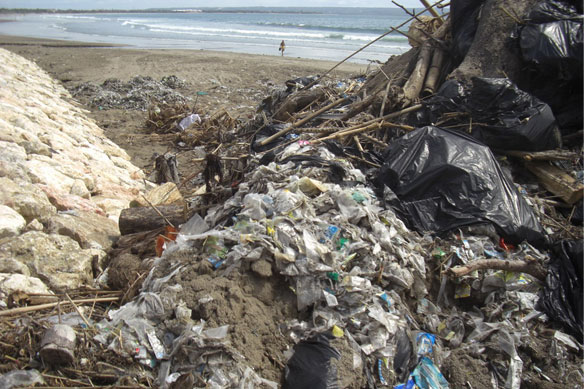
Kuta beach, Bali. Photo Source: Claude Graves
All sea creatures, from the largest to the microscopic organisms
are, at one point or another, swallowing the seawater soup instilled
with toxic chemicals from plastic decomposition. Much of ocean’s life is
in the microscopic size range and zooplankton is the base of the food
chain. As environmentalists remind the world’s population, “…We are
eating fish that have eaten other fish, which have eaten toxin-saturated
plastics. In essence, humans are eating their own waste…” (Dixit Renee
Brown, WiredPress).”
Beaches, Coast, Sea Floor, Shorelines
Blatantly visible is the plastic spill washing up on the shores and
beaches. Just a walk on any beach, anywhere in the world, and plastic
debris are found in one form or another. All over the world the
statistics are ever growing, just staggeringly. Last year, an estimated
150,000 tons of marine plastic debris washed up onto the shores of Japan
and 300 tons a day on India’s shores.
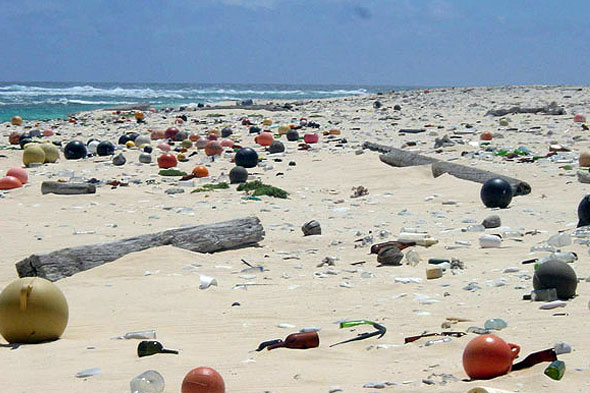
Layson Island, Hawaiian islands. Photo Source: NOAA
The Hawaiian Archipelago, extending from the southernmost island of
Hawaii 1,500 miles northwest to Kure Atoll, is among the longest and
most remote island chains in the world. The 19 islands of the
archipelago, including Midway atolls, receive massive quantities of
plastic debris, shot out from the Pacific gyres. Some of the plastic
litter is decades old. Some beaches are buried under 5 to 10 feet of
plastic trash, while other beaches are riddled with “plastic sand,”
millions of grain-like pieces of plastic that are practically impossible
to clean up. One of the reasons marine debris accumulates in these
islands is the movement of debris within the North Pacific Subtropical
Convergence Zone (STCZ), as we have explained supra.
Two studies on several islands off Jakarta Bay and islands further
to the northwest in the Java Sea, reported that debris pollution on
shorelines had substantially increased between 1985 and 1995 (Uneputty
and Evans 1997b, Willoughby et al. 1997). Both studies noted that
results implicated Jakarta as a major source of the debris. On 23 of the
islands, it was reported that the total litter at the strandline ranged
from not detectable to 29.1 items/m (Willoughby et al. 1997). Plastic
bags, polystyrene blocks, and discarded footwear accounted for 80
percent of the items found.
Researchers Barnes and Milner (2005) list five studies which have
shown increases in accumulation rates of debris on mid to high latitude
coasts of the southern hemisphere.
Surveys of shorelines around the world, reported by Greenpeace,
have recorded the quantity of marine debris either as the number of
items per km of shoreline or the number of items per square meter of
shoreline. The highest values reported were for Indonesia (up to 29.1
items per m) and Sicily (up to 231 items per m).

Seabed Pollution. Photo Source: Bouteilles à la mer org.
It’s been reported by Greenpeace that an estimated 70 percent of
the mass of fragmented plastic present in the open oceans of the world
does sink to the deep-sea bed. A limited body of literature exists,
though, concerning these small to microscopic particles (micro debris)
mirroring the little research addressed to marine litter on the sea
floor.
Ecosystem Changes
Another effect of the plastic tide that goes beyond visual is its potentiality to change entire ecosystems.
“Plastic is not just an aesthetic problem,” says marine biologist
David Barnes of the British Antarctic Survey. “It can actually change
entire ecosystems.” He has documented that plastic debris which floats
on the oceans, acts as rafts for small sea creatures to grow and travel
on. This represents a potential threat for the marine environment should
an alien species become established. It is postulated that the slow
speed at which plastic debris crosses oceans makes it an ideal vehicle
for this. The organisms have plenty of time to adapt to different water
and climatic conditions.
Coral Reefs
Derelict fishing gear can be destructive to coral reefs. Corals are
in fact animals, even though they may exhibit some of the
characteristics of plants and are often mistaken for rocks. In
scientific classification, corals fall under the phylum Cnidaria and the
class Anthozoa. They are relatives of jellyfish and anemones. (NOAA)
Nets and lines become snagged on coral and subsequent wave action
causes coral heads to break off at points where the debris was attached.
Once freed, debris can again snag on more coral and the whole process
is repeated. This cycle continues until the debris is removed or becomes
weighted down with enough broken coral to sink (NOAA 2005a).
Eventually, derelict fishing gear may become incorporated into the reef
structure.
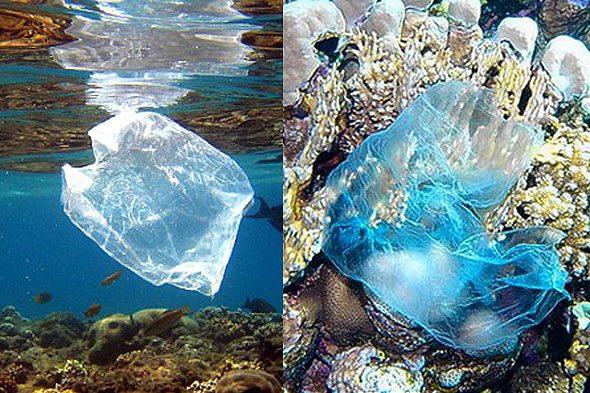
Plastic on Coral. Photo Source: EPA
Plastic bags can kill coral by covering and suffocating them, or by
blocking sunlight needed by the coral to survive. During 2001, so many
plastic bags were regularly seen in the Gulf of Aqaba, off the coast of
Jordan, that the Board of Aqaba Special Economic Zone issued a law
banning the production, distribution, and trade of plastic bags within
the areas under their jurisdiction.
Economics
Marine litter cause serious economic losses to various sectors and
authorities. Among the most seriously affected are coastal communities
(increased expenditures for beach cleaning, public health and waste
disposal), tourism (loss of income, bad publicity), shipping (costs
associated with fouled propellers, damaged engines, litter removal and
waste management in harbors), fishing (reduced and lost catch, damaged
nets and other fishing gear, fouled propellers, contamination), fish
farming and coastal agriculture.

Haina, Dominican Republic. Photo Source: Eduardo Munoz
In a 2007 Fortune Magazine article about India, it was written that
the costs of river pollution to the economy are enormous. Waterborne
diseases are India’s leading cause of childhood mortality. Shreekant
Gupta, a professor at the Delhi School of Economics who specializes in
the environment, estimates that lost productivity from death and disease
resulting from river pollution and other environmental damage is
equivalent to about 4 percent of gross domestic product.
The bill for cleaning the beaches in Bohuslän, on the west coast of
Sweden, in just one year was reportedly at least 10 million SEK or
$1,550,200. In Britain, Shetland fishermen reported that 92 per cent of
them had recurring problems with debris in nets, with each boat losing
between $10,500 and $53,300 per year as a result of marine litter. The
cost to the local industry could be as high as $4,300,000. The
municipality of Ventanillas in Peru has calculated that it would have to
invest around $400,000 a year in order to clean its coastline, while
its annual budget for cleaning all public areas is only half that
amount. (Unep)
Our Oceans and coastlines are under unprecedented plastics waste
attack. It’s coming back at us in many ways. It’s a dire problem that
only received serious scientific and public attention in the early 90’s,
as we know, but all along the perpetrators have simply and clearly been
identified.
The Aggressors
The obvious and simple answer is: us…
Behind each and every piece of littered plastic debris there is a
human face. At a critical decision point, someone, somewhere, mishandled
it, either thoughtlessly or deliberately. Cigarette filters and cigar
tips, fishing line, rope and gear, baby diapers and nappies, six-pack
rings, beverage bottles and cans, disposable syringes, tires, the litany
of plastic litter is as varied as the products available in the global
marketplace, but it all shares a common origin.
Sources
260 million tons per year is our estimated plastic consumption, 6
789 billion, is the estimated world population (United States Census
Bureau, as of October 2009). Our voracious appetite for plastics,
coupled with a culture of discarding products that we have chosen for
their inherent longevity, is a combination of lethal nature for our
environment.
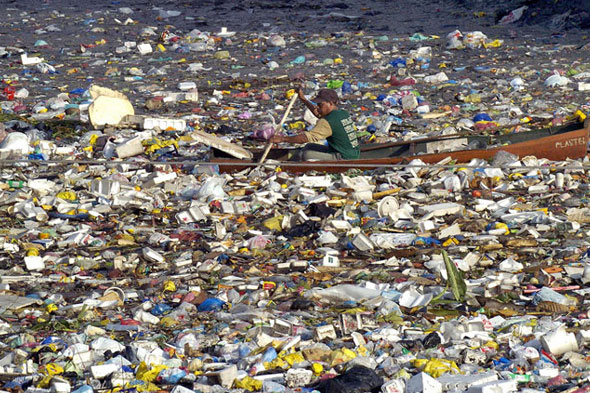
Plastic Sea. Photo Source: Coastal wiki
The ultimate symbol of our throwaway lifestyle is the plastic bag:
500 billion to 1 trillion plastic bags is the number consumed annually,
which is about a million a minute. The production of plastic bags
creates enough solid waste per year to fill the Empire State Building
two and a half times. The petroleum used to make only 14 plastic bags
could drive a car 1 mile.
Plastic bags are commonly found in waterways, on beaches, and in
other unofficial dumping sites across China, for instance. Litter caused
by the notorious bags has been referred to as “white pollution.”
In the United States, however, measures to ban or curtail the use
of plastic bags have met with official resistance. With its powerful
lobby, the plastics industry argues that jobs will disappear. The
industry employs some two million workers. Americans alone throw out at
least 100 billion bags a year, the equivalent of throwing away 12
million gallons of oil, which seems an intolerable waste. Until the U.S.
follows the lead of San Francisco, China, Ireland, Uganda, South
Africa, Russia, and Hong Kong and targets the reduction of plastic bags
using legislature, we each need to make a conscious choice and refuse to
use it.
The core of the plastic waste instillation in world’s oceans is
primarily rooted in poor practices of solid waste management, a lack of
infrastructure, various human activities, an inadequate understanding on
the part of the public of the potential consequences of their actions,
the lack of adequate legal and enforcement systems nationally and
internationally, and a lack of financial resources affected to the
cause. Mainly a consensus needs to happen, as a culture of behavioral
changes needs to be promoted.
The four main land-sources of plastics debris have been identified as:
-
Shoreline and recreational activities related litter
This includes: bags, balloons, beverages bottles, cans, caps,
lids, shoes, cups, plates, forks, knives, spoons, food
wrappers/containers, six-pack holders, pull tabs, shotgun
shells/wadding, straws, stirrers, toys, medical hygiene (condom,
syringe), drug and smoking paraphernalia (The filters are made of
cellulose acetate, a synthetic polymer (fiber) that can last for many
years in the environment), and 55 gallons drums. All this land-based
debris blows, washes, or is discharged into the water from land areas
after people engaged in beach-going activities have discarded it.
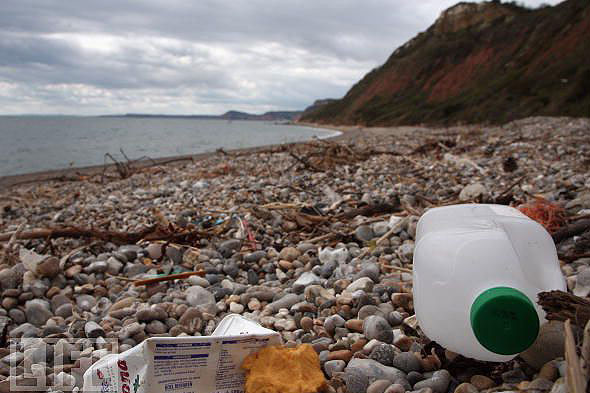
Branscombe, United Kingdom, Photo: Matt Cardy
About 80 percent of all tourist flock to coastal areas. Massive
influxes of tourists, often to a relatively small area, have a huge
impact, adding to the pollution of the local population, putting local
infrastructure and habitats under enormous pressure. For example, 85
percent of the 1.8 million people who visit Australia’s Great Barrier
Reef are concentrated in two small areas, Cairns and the Whitsunday
Islands, which together have a human population of just 130,000 or so,
WWF reported.
Shoreline activities account for 58 percent of the marine litter
in the Baltic Sea region and almost half in Japan and the Republic of
Korea. In Jordan, recreational activities contribute up to 67 percent of
the total discharge of marine litter. This is a particularly big
problem in the East Asian Seas region – home to 1.8 billion people, 60
percent of whom live in coastal areas – with its fast growing shipping
and industrial development. Other emerging hotspots include the oil-boom
coasts of the Caspian and the littoral states of Iran and Azerbaijan.
In South Asia, the growing ship-breaking industry has become a
major source of marine debris. In Gujarat, India – one of the largest
and busiest ship-breaking yards in the world – operations are carried
out on a 10-kilometer stretch on the beaches of Alang, generating
peeled-off paint chips and other types of non-degradable solid waste
making its way into the sea.
-
Sewage (waste waters containing plastic type products, rivers, waterways)
Under normal, dry weather conditions, most wastes are screened
out of sewage in countries that do apply strict sewage treatment.
However, materials can bypass treatment systems and enter waterways when
rain levels exceed sewage treatment facilities’ handling capacity.
During these times, sewage overflows occur.
The Yamuna River, which flows 855 miles from the Himalayas into
the Ganges, is one of India’s most, but not only, polluted river. The
Centre for Science and Environment says that nearly 80 percent of the
river’s pollution is the result of sewage. Combined with industrial
runoff, that comes to more than three billion liters of waste per day, a
quantity well beyond the river’s assimilative capacity. Many Indian
rivers are so polluted they exceed permissible levels for safe bathing.
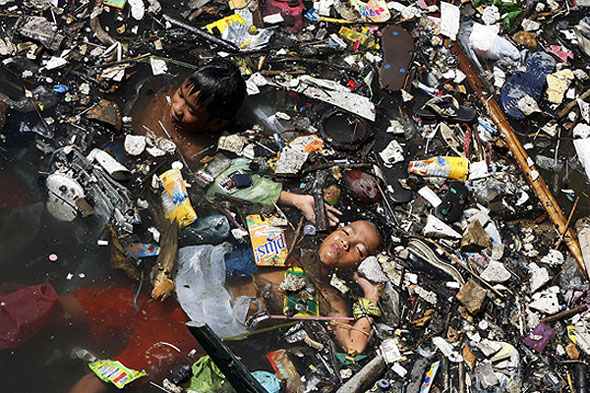
Yamuna River in New Delhi. Photo: Manan Vastsyayana
It has been reported that the lack of adequate solid waste
management facilities results in hazardous wastes entering the waters of
the Western Indian Ocean, South Asian Seas, and southern Black Sea,
among others.
-
Fishing related debris
Dumping, wastes from ships, boats platforms (20%). Derraik (2002)
stated that ships are estimated to dump 6.5 million tons of plastic a
year. An estimated fourth fifths of the oceanic debris is litter blown
seaward from landfills and urban runoff washed down storm drains.
(Unep). Clean up on land where 80 percent of the plastic debris
originates is thus the primarily obvious answer.
Manual Clean Up
The simplest, yet highly effective, action is the manual clean up of the beaches, coasts, rivers, lands and estuaries.
National and international manual clean-up operations of shorelines and sea floor are in existence.
For instance, the past 20 years, the Japan Environmental Action
Network (JEAN) has been organizing a yearly beach cleanup and survey.
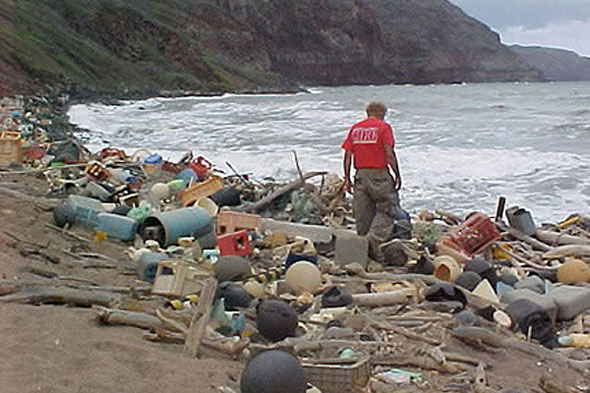
Hawaiin shores. Photo Source: epa.gov
On an international level, the International Coastal Cleanup (ICC)
was installed. The International Coastal Cleanup (ICC) engages the
public to remove trash and debris from the world’s beaches and
waterways, to identify the sources of debris, and to change the
behaviors that cause pollution. The origins of the ICC began in 1985
with research conducted by The Ocean Conservancy (then known as the
Center for Marine Conservation – CMC) on plastics in the marine
environment. Contracted by the U.S. Environmental Protection Agency,
Office of Toxic Substances, the CMC produced the report
Plastics in the Ocean: More Than a Litter Problem,
which was the first study to identify plastics as a significant marine
debris hazard. The data collected and analyzed from the annual ICC
Cleanup is used locally, nationally and internationally to influence
policy decisions, spawn campaigns for recycling programs, support public
education programs, launch adopt-a-beach programs, and even storm water
system overhaul and legislative reform.
The Clean Up the World program is run in conjunction with UNEP. It
engages more than 40 million people from 120 different countries in
clean up operations.
As part of its Rise Above Plastics campaign, Surfrider foundation
is hosting frequent beach clean-ups; it is an example of an encouraging
trend towards collective awareness and action to solve the problem at
its source.
Worldwide private groups and associations are more and more aware
that clean-up does need to happen, one day at a time, one person at a
time.
Cleaning Up Of The Oceans Debris In The Open Seas
NOAA has also been contacted regarding cleanup of the debris
directly in the garbage patch and other areas of the North Pacific;
however, cleanup is likely to be more difficult than it may seem. “If
only things were that simple. We could just go out there and scoop up an
island,” says Holly Bamford, director of NOAA’s marine debris program.
“If it was one big mass, it would make our jobs a whole lot easier.”
It’s like a galaxy of garbage, populated by billions of smaller trash
islands that may be hidden underwater or spread out over many miles.

Derelict nets at the GGP. Photo Source: 20tv
Furthermore, in some areas where marine debris concentrates so does
marine life, such as in the STCZ. This makes simple scooping up of the
material risky, more harm than good may be caused. Straining ocean
waters for plastics would capture the plankton that is the base of the
marine food web and responsible for 50 percent of the photosynthesis on
Earth. (NOAA).
As Captain Charles Moore once said: the cleaning up effort of the
oceanic garbage patches “would bankrupt any country and kill wildlife in
the nets as it went.”
However, confident in the future and investigating new horizons,
Doug Woodring, from Project Kaisei, will be producing a documentary for
National Geographic testing catch techniques for the plastic waste (“we
know not all can be caught, but some can for sure”), at least for the
largest debris that we know do decompose over time and actually more
rapidly than previously thought.

Marine debris accumulation, on seafloor. Photo Source: NOAA
The clean up operation is the most immediate, highly effective, and
simplest, action/plan that we, the problem, can undertake right now to
contribute to the solution. It is a great starting point for a
fundamental cultural change that need to occur, which is part of a major
consensus.
The Consensus
Undeniably a culture of behavioural changes, now in its infancy,
need to further blossom and be implemented/prompted at all levels:
individual, associative, governmental, legislative, industrial,
technological, educational, philosophical, national, and international.
It simply starts with individual choices. That is the enormous
task, yet the enormous power as well because it resides within each and
every one of us. Indeed, thanks to an increased awareness of the plastic
pollution spread, local, national, individual, and associative actions
have taken place worldwide to stop the plastic hemorrhage at the source.
Education, Legislation, and Awareness
Education
The starting point of all greater good does remain education and information.
More and more awareness and preventive programs are promoted.
For instance, in 2004, the Australian government launched a
campaign called Keep the Sea Plastic Free, in which it attempted to
educate the public to dispose of plastic waste properly.
Surfrider foundation is aiming to raise awareness of plastic marine
debris and reduce the proliferation of single-use plastic bags and
water bottles, as well as the number one littered item worldwide,
cigarette butts. The Rise Above Plastics program also seeks to promote a
more sustainable lifestyle and educate people about the prevalence of
plastic marine debris on our beaches and oceans and how deadly it can be
to marine life.

South East Asia – Philippines, 2008. Photo: Tamara Thoreson Pierce
The Indonesian government, for instance “(is) seriously concerned
about improving its waste management and informing the public,” quoted
the Jakarta Post, 2008. The head of the Maritime and Coastal Resources
Studies, Tridoyo Kusumastanto, said that both individual and industrial
dumpers should learn from scavengers who take solid waste out instead of
dumping it into rivers, canals and the sea.
Tridoyo estimated that some
40 tons of waste have been dumped into rivers and other waterways daily
in surrounding areas and thus polluting the Java Sea. A campaign
against river and sea pollution has been called, and people are urged to
change their culture of throwing garbage into waterways and other
common places.
Being educated on the situation and aware of the consequences
ultimately leads us toward better choices in term of consumption and
waste management of plastic at an individual level. It can be as simple
as refraining from discarding plastic after first use…plastic inherently
chosen for its durability.
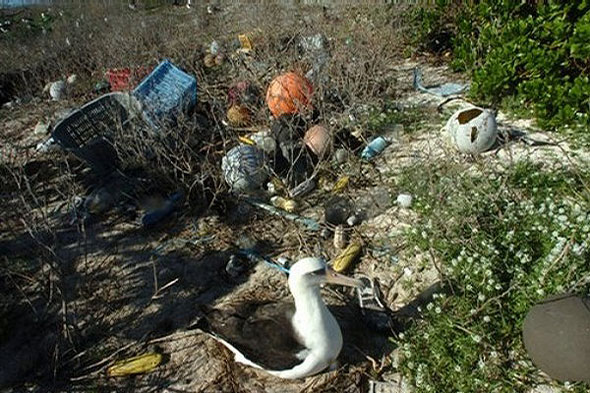
Albatrosses on Midway atoll. Photo Source: dailylife
As H. Takada mentioned: “We can’t avoid using plastic, but we use
too much. “In fact, he’s added a fourth “R” to the ecologist’s classic
mantra of reduce, reuse, recycle: refuse. The current bring-your-own-bag
movement at retail stores and supermarkets is a good start in terms of
refusing, he notes.
Instantaneous, prompt eradication of plastics in its current form,
rate of production, and consumption is not realistically feasible, yet
constant pressure is impacting industry and politicians to “think
green,” to have environmentally responsible approach, production,
prevention plans, and legislations.
Extend Producer Responsibility
Relentless associative campaigns have proven that change can
happen, such as the recent victory from the Uk’s Surfers Against Sewage
(SAS) campaign against mermaid tears.
“SAS launched a campaign to rid British coastlines of mermaid
tears, and will continue to build up until factory practice changes.” On
June 5th 2009, the release of the British Plastic Federation’s (BPF)
Operation Clean Sweep (OCS) guidance manual was a victory on the
preventive field. OCS is aimed at improving British plastic factories
efficient use of plastic pellets, commonly referred to as mermaid’s
tears.
SAS initially highlighted the problem of mermaid’s tears on UK
beaches to the BPF in 2007, delivering a bottle of 10,000 mermaid’s
tears, collected from one Cornish beach, to a BPF biopolymer seminar.
SAS also released a covert film documenting mermaid’s tears in the storm
drains of plastic factories in the southwest, highlighting the route
from factory to beach. SAS and the BPF have worked together on the OCS
solution. SAS has already signed up Contico, one of the southwest’s
largest plastic factories, to pilot some of the improvements within OCS.
Shoichiro Kobayashi, from The Japan Plastics Industry Federation,
says that its members have taken measures to reduce spillage of plastics
nurdles.
“Awareness of the problem is high,” says Kobayashi, and has been
since JEAN and other NPOs started publicizing the issue about 15 years
ago. The federation has about 1,000 members. Together with the
2,200-member All Japan Plastic Products Industrial Foundation, the two
groups represent the largest plastic producing companies in Japan.
Kobayashi says his organization encourages members and associated
transport companies to avoid spillage and to cover all drainage pipe
openings with wire mesh. That’s helped reduce the problem at larger
companies, but there are more than 20,000 producers of plastic goods in
Japan.
On September 22nd 2009 in California, a press conference was held
by DTC director Maziar Movassaghi and Project Kaisei founder Mary
Crowley, along with representatives from the State of California and
various nonprofit groups. They pushed for Extended Producer
Responsibility, the philosophy that companies that create products must
take responsibility for the full life cycle of those products, products
that are “benign by design.” Mary Crowley added, “Let’s reduce the
source of this pollution by not only choosing healthy, plastic-free
products ourselves, but also urging our legislators to pass Extended
Producer Responsibility legislation. In fact, such a bill is currently
on the table in the state of California. AB283, the California Product
Stewardship Act, is an important step in this process.”
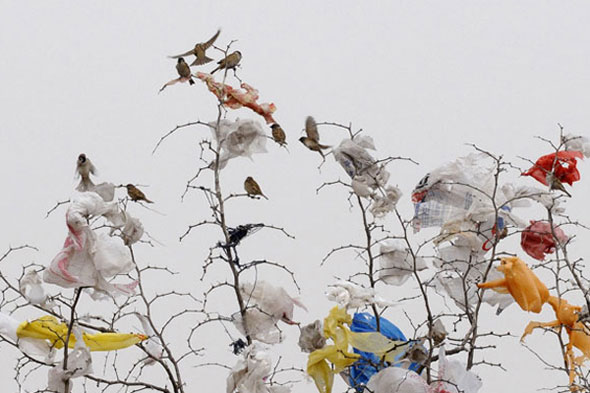
Changzhi, Shanxi Province. Photo: Stringer Shanghai
Local legislations, with clear frames and enforcements measures,
are increasingly being presented and passed in concert with
international programs and legislations, which need ratification by as
many countries as possible as the pollution is without frontiers.
Legislation And International Concerted Programs
Internationally
In 1972, the London Convention, a United Nations agreement to
control ocean dumping, was entered into. It was followed by the most
well known piece of International legislation, the International
Convention for the Prevention of Pollution from ships (MARPOL). Annex V
of MARPOL was introduced in 1988 with the intention of banning the
dumping of most garbage and all plastic materials from ships at sea. A
total of 122 countries have ratified the treaty. There is some evidence
that the implementation of MARPOL has helped to reduce the marine debris
problem.
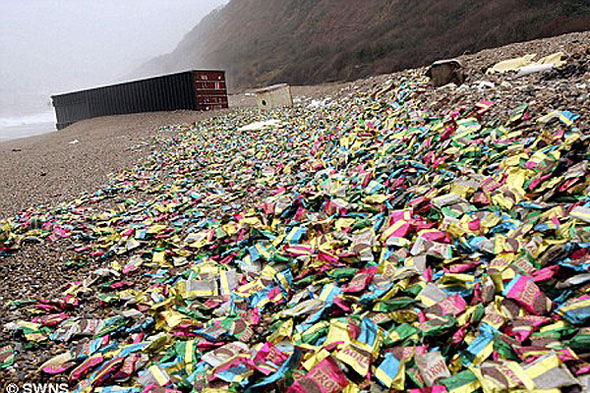
UK Beach. Photo Source: SWNS
In 1972 and 1974, conventions were held in Oslo and Paris,
respectively, which resulted in the passing of the OSPAR Convention, an
international treaty controlling marine pollution in the north-east
Atlantic Ocean around Europe. A similar Barcelona Convention exists to
protect the Mediterranean Sea.
The Water Framework Directive of 2000 is a
European Union directive committing EU member states to make their
inland and coastal waters free from human influence. In the United
Kingdom, the proposed Marine Bill is designed to “ensure clean healthy,
safe, productive and biologically diverse oceans and seas, by putting in
place better systems for delivering sustainable development of marine
and coastal environment”.
Under the umbrella of UNEP, numerous cooperative efforts have been
held to reach protocols and conventions.
For instance, a Protocol on
Integrated Coastal Zone Management was approved in January 2008,
involving 21 countries bordering the Mediterranean Sea, as well as the
European Union. Within the framework of Land Based Sources Protocol for
pollution reduction from land-based sources, Mediterranean countries and
parties to the Barcelona Convention have agreed this year on an initial
set of actions covering the reduction of municipal pollution and the
elimination of a number of Persistent Organic Pollutants.
The Caribbean Environment Programme (CEP) continues to encourage
member states in meeting the Caribbean Challenge target of protecting 20
percent of marine and coastal habitats by 2020. The Caribbean Large
Marine Ecosystem Project and development of a Regional Fund for
Wastewater Management will support regional collaboration to reduce the
vulnerability of sensitive coastal and marine ecosystems by improving
national and regional governance structures and developing new and
innovative mechanisms for financing new pollution reduction activities.
Even though the greatest problem with international legislation is
its actual enforcement, the efforts toward concerted actions can only
be promoted.
Nationally
A strict Chinese limit on ultra-thin plastic bags significantly
reduced bag-related pollution nationwide during the past year. “Our
country consumes a huge amount of plastic shopping bags each year” a
spokesperson for China’s State Council said, when announcing the ban
last May.
“While plastic shopping bags provide convenience to consumers,
this has caused a serious waste of energy and resources and
environmental pollution because of excessive usage, inadequate recycling
and other reasons.” In January 2008, The State Council, China’s
parliament, passed legislation to prohibit shops and supermarkets from
providing free plastic bags that are less than 0.025 millimeters thick.
The State Administration of Industry and Commerce also threatened to
fine shopkeepers and vendors as much as 10,000 Yuan ($1,465) if they
were caught distributing free bags.
The country avoided the use of 40
billion bags, according to government estimates. The National
Development and Reform Commission (NDRC) estimated that the limit in bag
production saved China 1.6 million tons of petroleum.
The first country to ban plastic bags was Bangladesh, which did so
in 2002. Following a particularly damaging typhoon, authorities
discovered that millions of bags were clogging the country’s system of
flood drains, contributing to the destruction.
In the same year, Ireland took another approach and instituted a
steep tax on plastics. According to the country’s Ministry of
Environment, use fell by 90 percent as a result and the tax money that
was generated funded a greatly expanded recycling program throughout the
country. In 2003, the government of Taiwan put in place a system by
which bags were no longer made available in markets without charge.
Carryout restaurants were even required to charge for plastic utensils.
Larger economies have joined the cause and passed legislations on a
national level. In 2005, French legislators imposed a ban on all
non-biodegradable plastic bags, which will go into effect in 2010. Italy
will also ban them that year.
During its 2008 session, the New York State Legislature passed
legislation requiring the reduction, reuse, and recycling of checkout
bags. The previous year, the city of San Francisco banned plastic bags
altogether, at least the flimsy ones of yore. National Public Radio
reported a few months later that the ban had been a boom for local
plastics manufacturers, who have been introducing heavy-duty,
recyclable, and even compostable bags into the marketplace.
An impactful vehicle for information and awareness is indubitably found in the media and creative ventures.
A good example of such ventures is the team of two South African
surfers, Ryan and Bryson Robertson, and one Canadian, Hugh Patterson,
who created the OceanGybe mission. Their plan is to circumnavigate the
globe in a small 40ft sailboat and surf remote reef breaks on far flung
islands while interacting with the local cultures. They intend to spread
awareness of the vast tracts of plastic and trash afloat on the world’s
oceans that inevitably ends up on some unsuspecting shore.
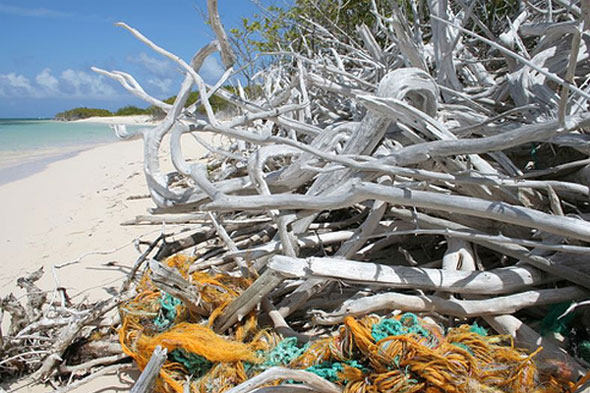
Fishing debris on beach. Photo Source: unknown
More publicized and funded is the environmentalist and Adventure
Ecology founder David de Rothschild’s expedition: the Plastiki mission.
The Plastiki, a one-of-a-kind 60-foot catamaran, was created out
of 10,000 reclaimed plastic soda bottles, self-reinforced PET
(polyethylene terephthalate) and recycled materials. The vessel’s name
is a nod to famed explorer Thor Heyerdahl, who led a 1947 voyage on the
Kon-Tiki to test theories of Polynesian settlement by South Americans.
The Plastiki is about to make its momentous voyage across the Pacific
Ocean, a 10,000-mile expedition from San Francisco to Sydney, Australia
by the end of this year, to inspire people to rethink current uses and
waste of plastic as a resource and bring attention to the GGP.
De Rothschild explained that Plastiki’s construction has already
jump-started research into a future “smart plastics” industry before
ever leaving port. For instance, studies are underway on glues that
could someday replace common marine epoxies and plastics that could
replace non-recyclable fiberglass.
“The Plastiki voyage will be a great adventure, but I think more
exciting is the ability to create a conversation on the issue of
plastics.”
Philosophy
Adventures of philosophical nature have been taking place as well.
Indeed, French thinkers such as Michel Serre or Luc Ferry, The new
ecological order, have developed a train of thought aiming towards a
legal recognition, therefore legal protection of Nature. This type of
philosophy has been called, deep ecology. The principle is quite simple:
democracies have installed their legislative framework, their “social
contract,” omitting Nature as a protagonist/subject of law. Therefore,
to protect Nature, i.e. our environment, should we confer legal right to
it, thus making nature a legal subject/person?
Obviously, all subject of law have rights, but they also have
obligations. If we can easily forsee what the right and protection would
be for this legal subject, what would be its obligations?
This leads many thinkers towards a notion of “droit ou devoir
d’ingerence ecologique” (right or duty of intervention/assistance),
trying to mirror the situation on the humanitarian field. The notions of
“self defense” and “non assistance a personne en danger” have also been
explored as possible legal frames to better enforcement of laws and
conventions aimed to protect the environment, and curb ocean plastic
pollution for that matter.
Sustainable And Future Technologies – Opportunities and Innovations
-
Biodegradable plastics
Biodegradable plastics have been considered as a future,
sustainable option to curb our voracious demand and consumption of
plastic material as known in its current form. According to the
Biodegradable Plastics Society (2005), when such plastics are composted
they break down to carbon dioxide and water.
Controversy does exist though, because it is possible that
biodegradable plastics do not break down fully, especially under
environmental conditions which are not ideal for composting, and leave
non-degradable constituents, some of which may be equally, if not more,
hazardous. Also, there is a danger that biodegradable plastics will be
seen as “litter friendly” materials, conveying the wrong message to the
public and potentially leading to less responsible and more wasteful
practices.
A change in behavioral propensities to over-consume plastics, discard and thus pollute, need to be promoted to the fullest.
-
Ongoing discoveries and solutions to the traditional plastic waste problem
Scientists have been searching for solutions to the traditional plastic waste problem.
In 2008 and 2009, two high school students who discovered
plastic-consuming microorganisms, might have found groundbreaking
solutions.
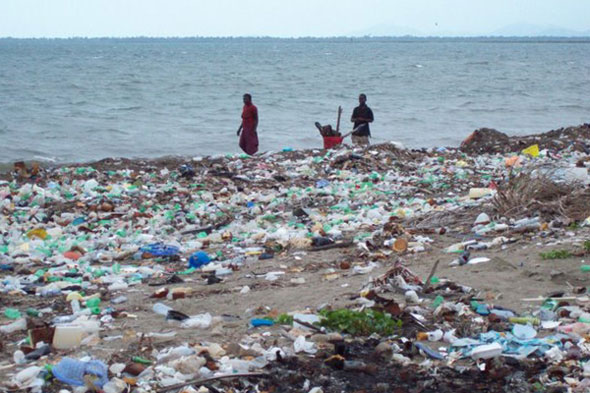
Haitian Coast. Photo Source: unknown
The first was Daniel Burd (2008). The second was Tseng I-Ching(l May 2009), a high school student in Taiwan.
Daniel’s simple and clever process was to immerse ground plastic
in a yeast solution that encourages microbial growth, then isolating the
most productive organisms. After several weeks of tweaking and
optimizing temperatures, Burd was achieved a 43 percent degradation of
plastic in six weeks, an almost inconceivable accomplishment. It
appeared as an environmentalist’s dream: a non-chemical, i.e. fully
organic, low cost and nontoxic method for degrading plastic.
There have been several successful bacteria based solutions
developed at the Dept. of Biotechnology in Tottori, Japan, as well as at
the Dept. of Microbiology at the National University of Ireland, but
both apply only to styrene compounds.
Similarly, a 2004 study at the University of Wisconsin isolated a
fungus capable of biodegrading phenol-formaldehyde polymers previously
thought to be non-biodegradable.
-
Green chemistry and “begnign by design” concept
A growing interest amongst chemists, and ultimately industries, is Green chemistry- policy, also called “benign by design”.
According to scientists at the University of Southern Mississippi
(USM), a new type of environmentally friendly plastic that degrades in
seawater may be developed. Robson F. Storey, Ph.D., a professor of
Polymer Science and Engineering at USM, said, “We’re moving toward
making plastics more sustainable, especially those that are used at
sea.” Their study is funded by the Naval Sea Systems Command (NAVSEA),
which is supporting a number of ongoing research projects aimed at
reducing the environmental impact of marine waste. The new plastics are
made of polyurethane that has been modified by the incorporation of PLGA
[poly (lactide-co-glycolide)], a known degradable polymer used in
surgical sutures and controlled drug-delivery applications. When exposed
to seawater, the plastics degrade via hydrolysis into nontoxic
products, according to the scientists. The plastics are not quite ready
for commercialization. “More studies are needed to optimize the plastics
for various environmental conditions they might encounter, including
changes in temperature, humidity and seawater composition”, Storey says.
A new kind of material, called oxo-biodegradable plastic, does
not just fragment, but is consumed by microorganisms after the additive
has reduced the molecular weight. It is thus biodegradable. This process
continues until the material has biodegraded to nothing more than CO2,
water, humus, and trace elements. There is little or no additional cost,
as it can be made with the same machinery and workforce as conventional
plastic. The time taken to degrade can be programmed to a few months or
a few years and, until the plastic degrades, it has the same strength
and other characteristics as conventional plastic. Oxo-biodegradable
plastic will be engineered to degrade in a short time leaving no harmful
residues.
-
Recycling and Zero Waste concept
A promising way toward a future of better plastic waste
management is recycling the material. The recycling industry might
eventually be a path leading to considerable opportunities and
solutions.
The BIR (Bureau of International Recycling), whose headquarters
is in Belgium, is a trade federation representing the world’s recycling
industry. About 800 companies and national federations from over 70
countries are affiliated with the BIR. Together they provide their
expertise to other industrial sectors and political groups in order to
promote recycling. It is estimated that the recycling industry employs
more than 1.5 million people, annually processes over 500 million tons
of commodities, and has a turnover exceeding $160 billion.
However, this industry is faced with many challenges, as the
recycling material itself is very diverse in a chemical sense and can
release, when processed, extremely dangerous chemicals. For instance, a
recycling factory in China was recently exposed to tragic consequences
due to the recycling of very hazardous plastic materials. It was
reported that a team of workers in China’s Zhejiang province collapsed
after handling two metric tons of plastic scrap on September 13, 2009.
At least 21 have since been hospitalized and three of them have died.
According to the initial investigative conclusions, the victims were in
contact with highly toxic chemical, dinitrophenol, which was found on
the two tons of plastic scrap. Workers at the recycling factory were
unaware of the hazard of the material and had no protection during the
unloading. This particular tragedy is only the tip of the iceberg.
China’s plastics recycling industry is poorly regulated, with scandals
such as biohazard plastic waste being melted and reprocessed into
consumer goods.
Recycling is definitely a potentially great path to solving the
plastic waste problem but definitely not the most unchallenging one.
Along the same lines, a responsible waste strategy, namely the concept
of Zero Waste, has been widespread. Such a strategy encompasses waste
reduction, reuse and recycling as well as producer responsibility and
ecodesign. According to a Greenpeace report, strategies to achieve Zero
Waste are adopted throughout the world, in industrialized countries and
in less developed countries.
Ultimately, this would mean reduction of the use of plastics.
“Our understanding of disposal and reuse (of plastic, is what) is to
blame.” as many environmentalist such as de Rothschild, said.
This zero waste philosophy encourages the redesign of resource’s
life cycles, so that all products are reused. Any trash sent to
landfills is minimal. The process recommended is one similar to the way
that resources are reused in nature. Zero waste can represent an
economical alternative to waste systems, where new resources are
continually required to replenish wasted raw materials.
DTSC’s Environmental Chemistry Laboratory is currently analyzing
some of the plastic marine debris collected at the Great Garbage Patch
by Project Kaisei scientists, and explores the potential of converting
the plastic collected into new material.
Indeed, Doug Woodring from Project Kaisei stated last September
that they intend to use some of the newest plastic technologies to
detoxify and turn the plastic waste caught in the oceans either into
fuel or another useable material. Thus, Project Kaisei hopes to assign
value to that plastic collected, particularly the overwhelming majority
that is never recycled. It becomes obvious that technologies that
convert plastic to fuel, clothing, or simply more profitable plastic
could give people a good reason to pick up all that plastic and make a
profit from it. Numerous industries, such as fashion, are already
increasingly focusing on new green materials as a base for their offered
products, encouraging a way of life and cultural change toward better
choices and awareness of the environment.
“It’s controllable,” DougWoodring said. “We have to let people
know that enough is enough, but it’s not just a negative story about
toxicity and wrecking our oceans. There is a huge amount of opportunity
for innovation.”
Conclusion
“The impossible missions are the only ones which succeed.”
—Commandant Jacques-Yves Cousteau.
The abysmal depth and extent of the task before us ought to be
never as inexhaustible and boundless as our dedication and compelling
strive to greater changes.











































